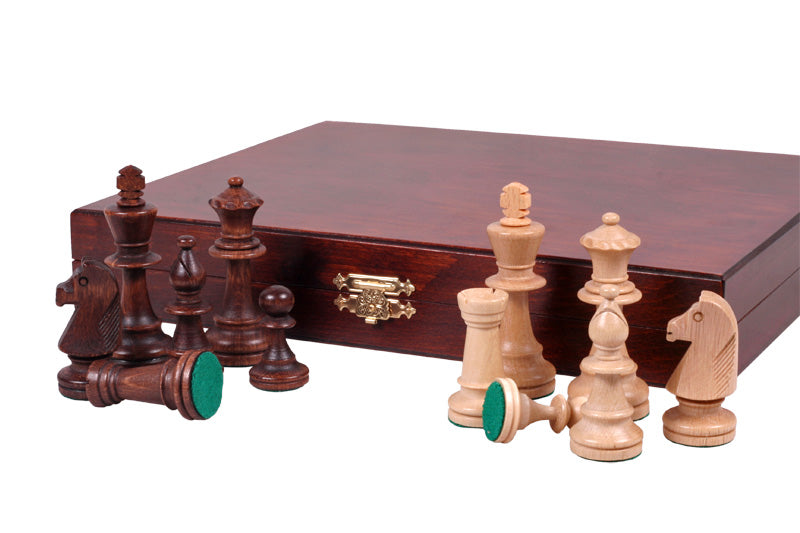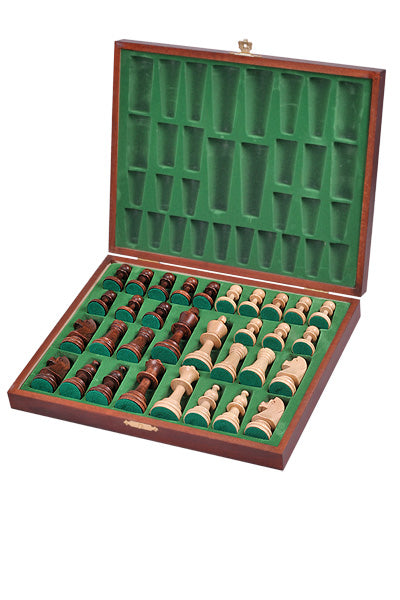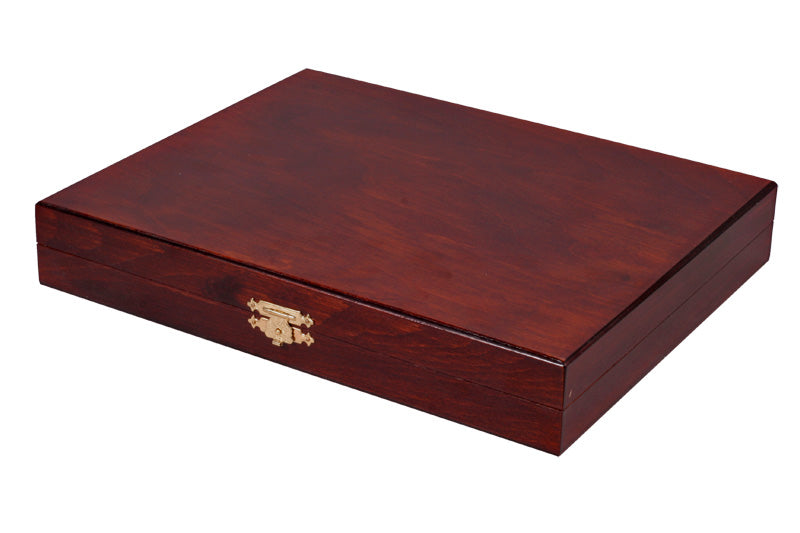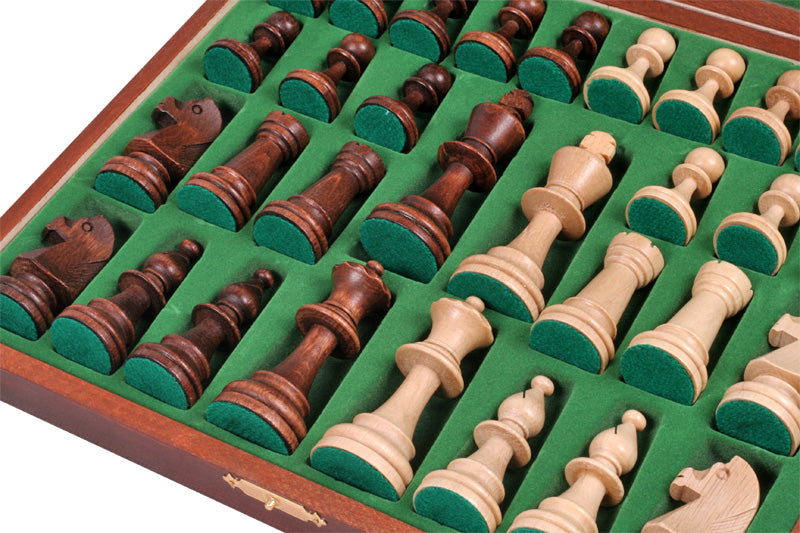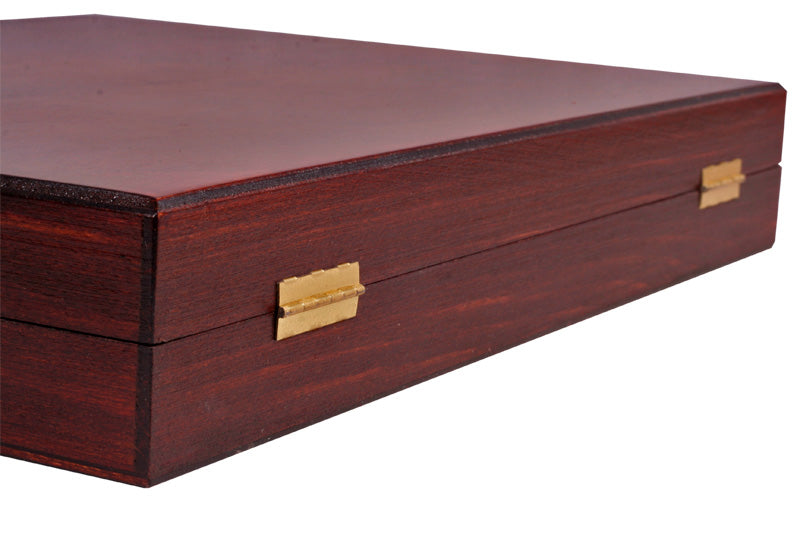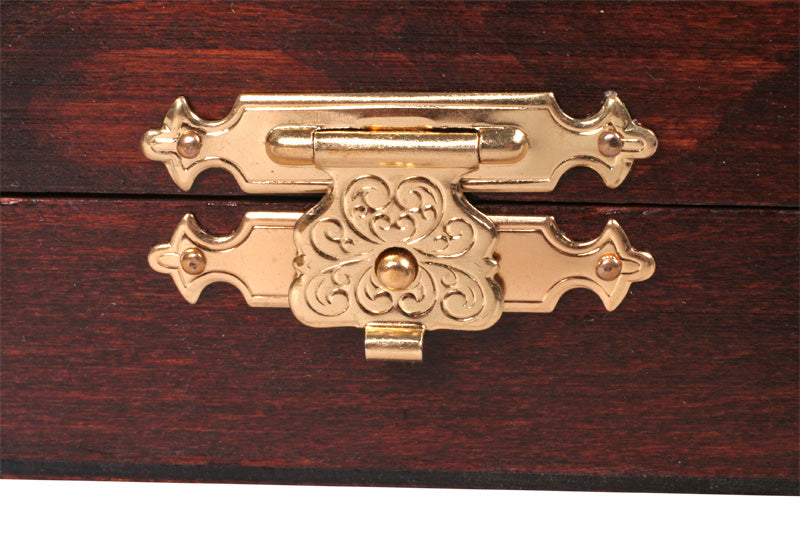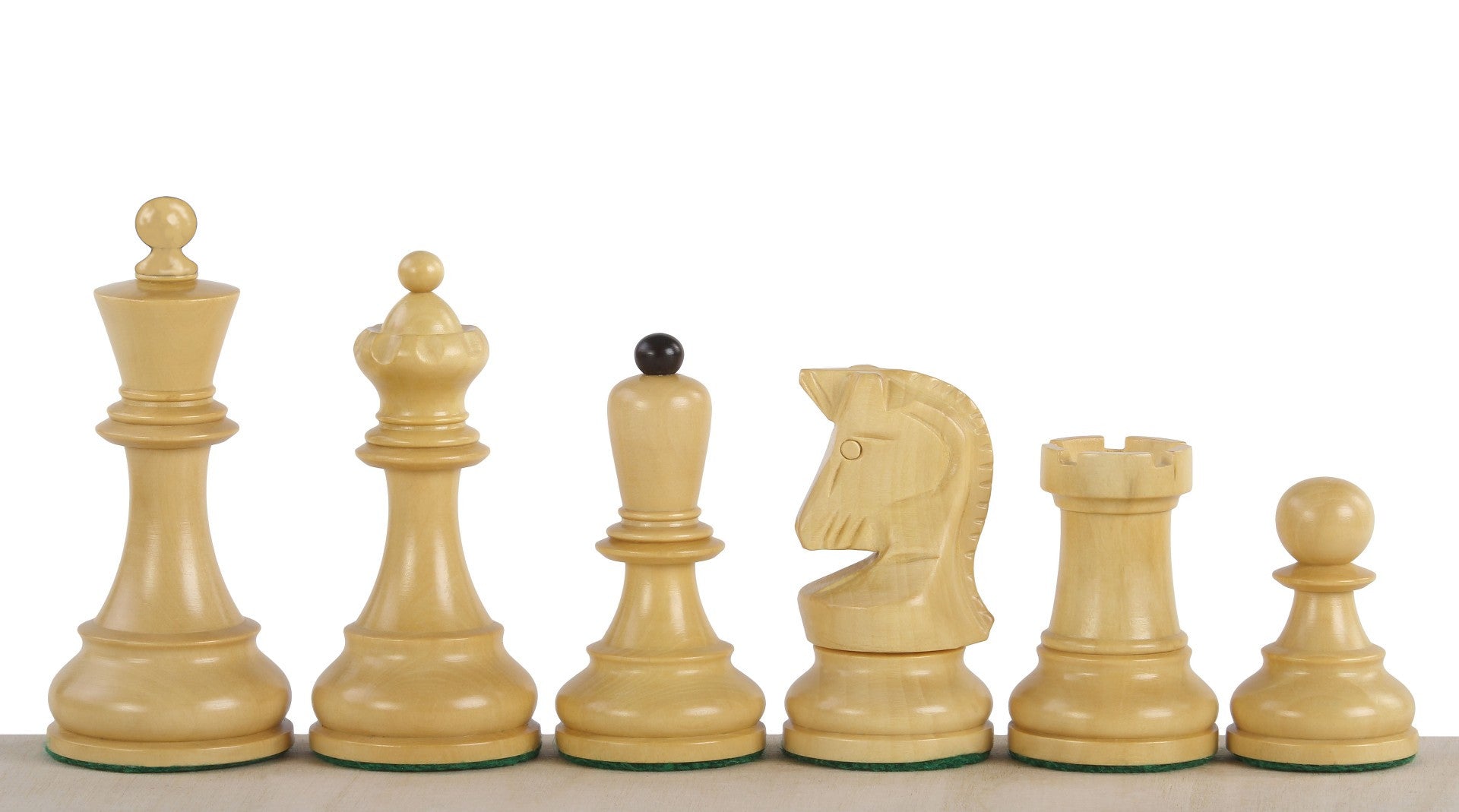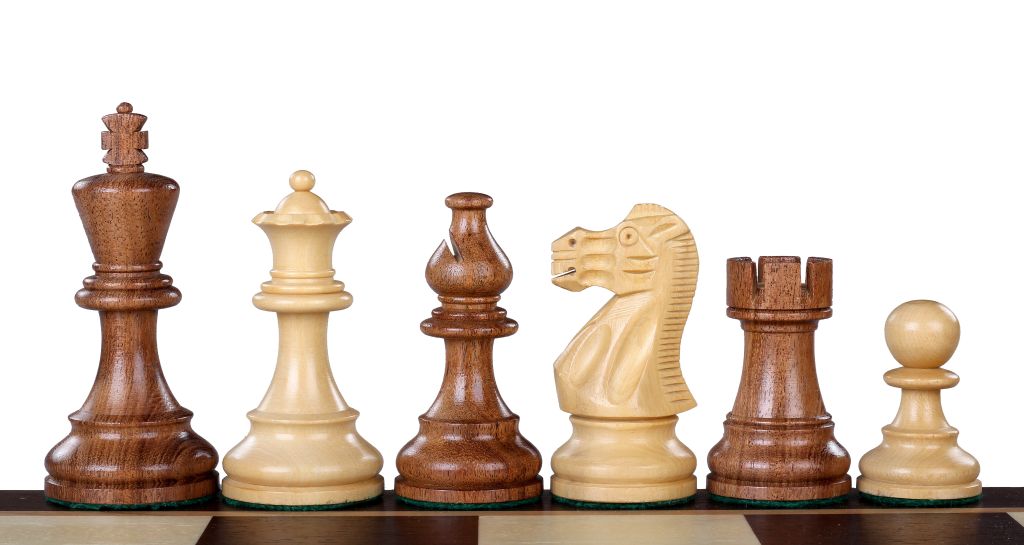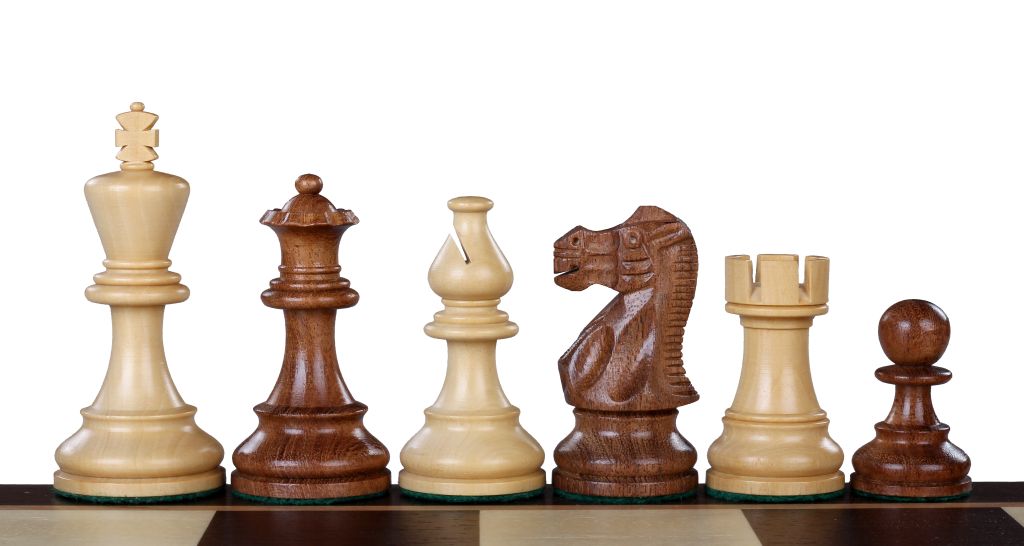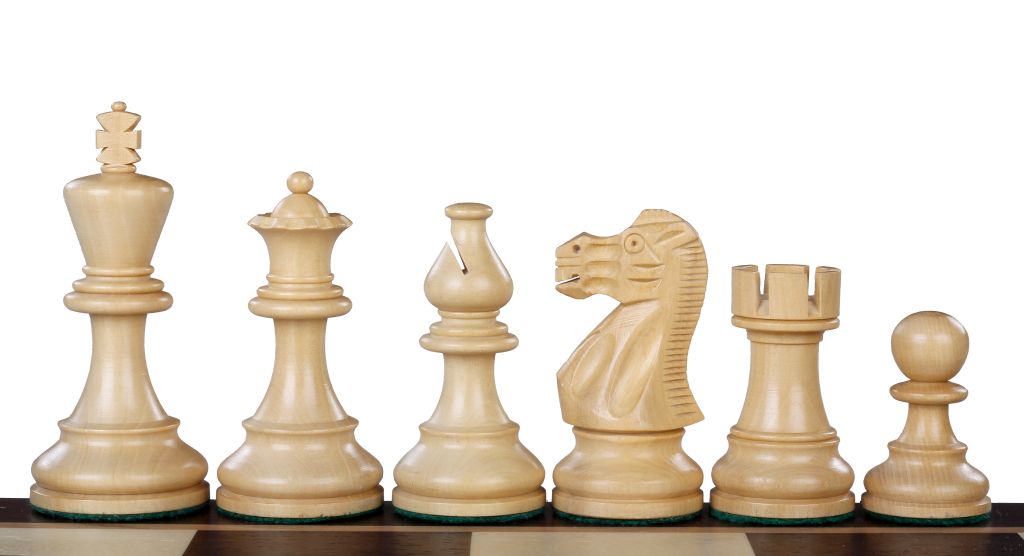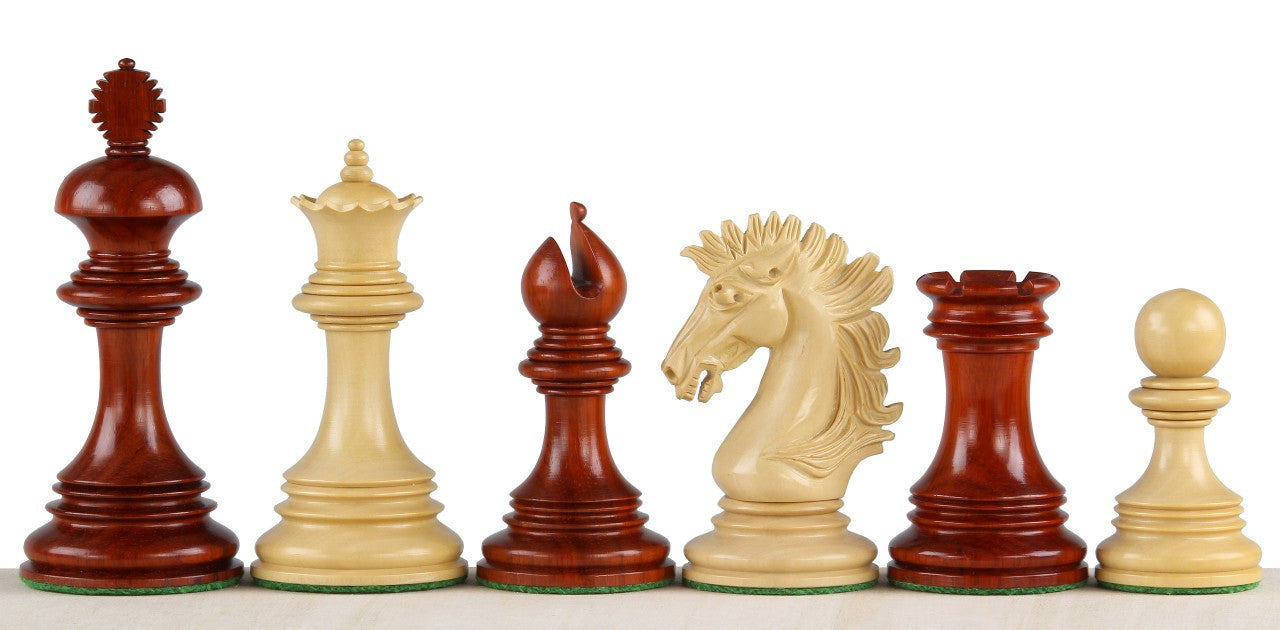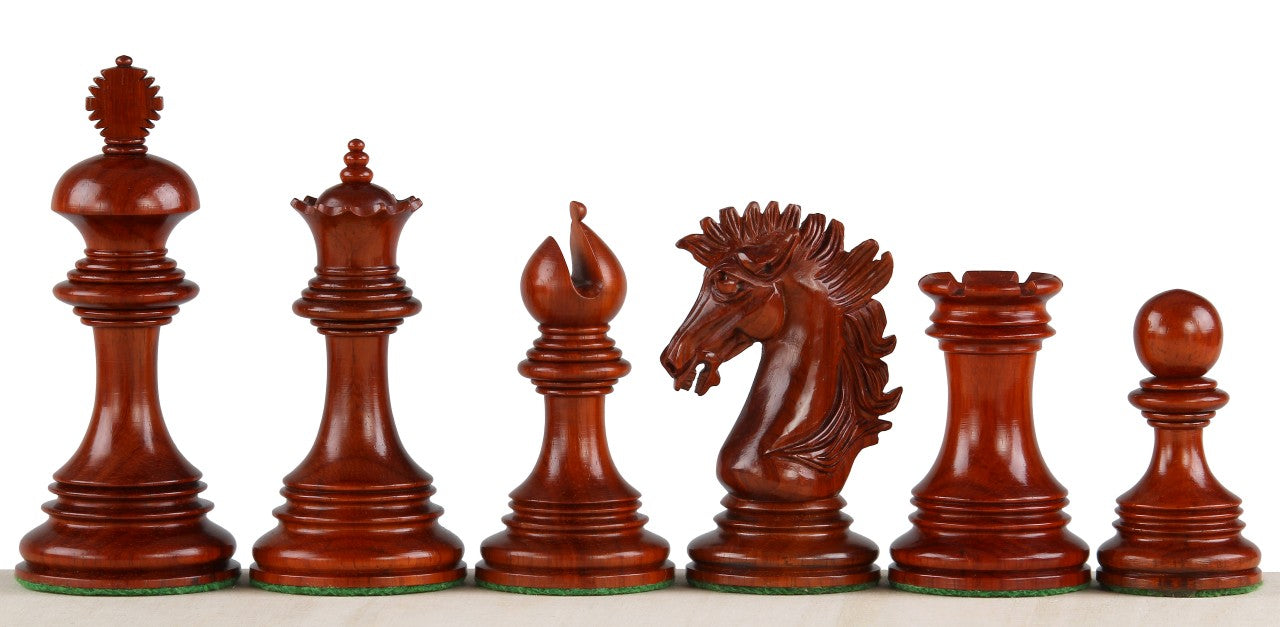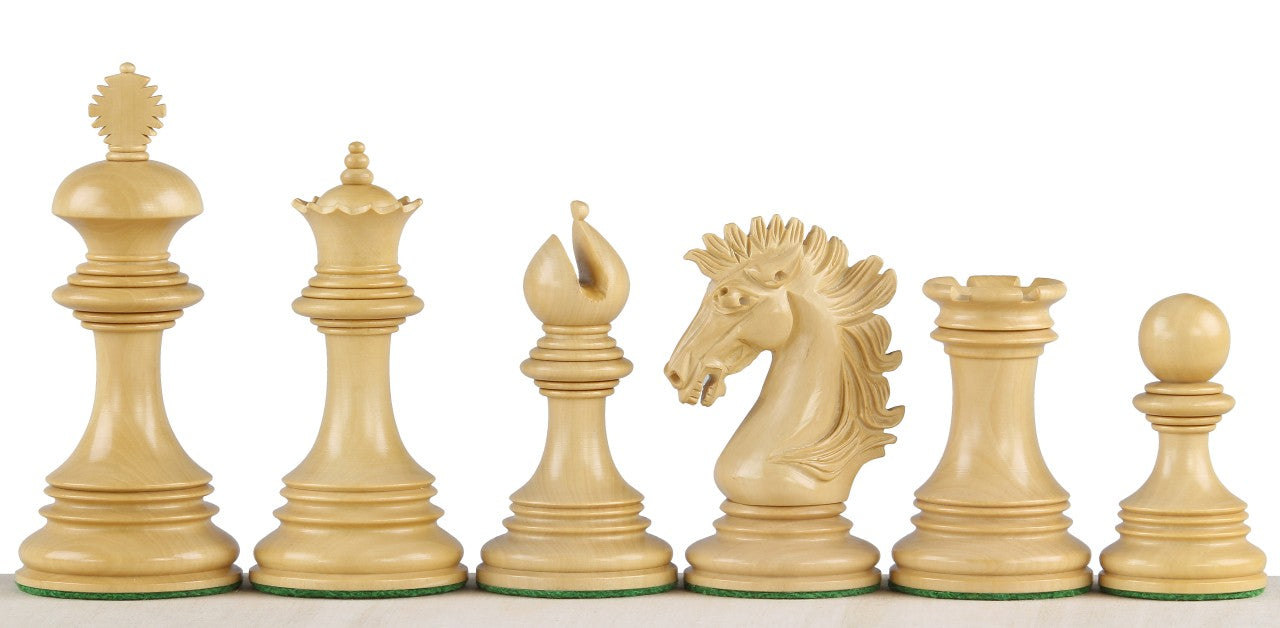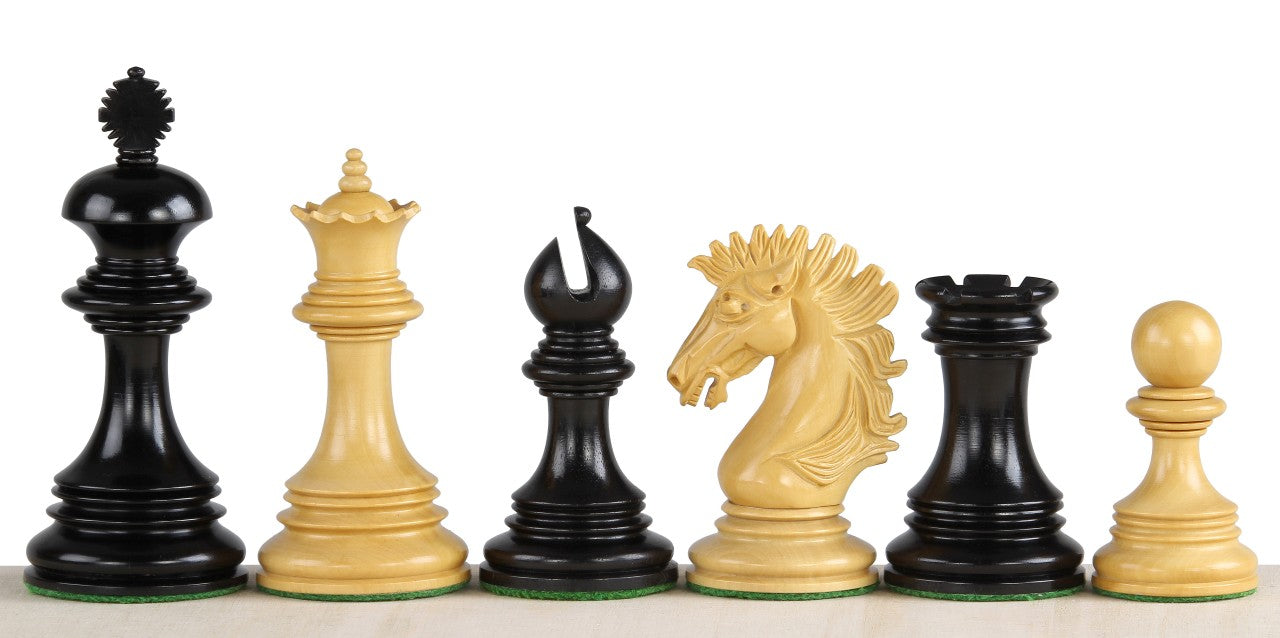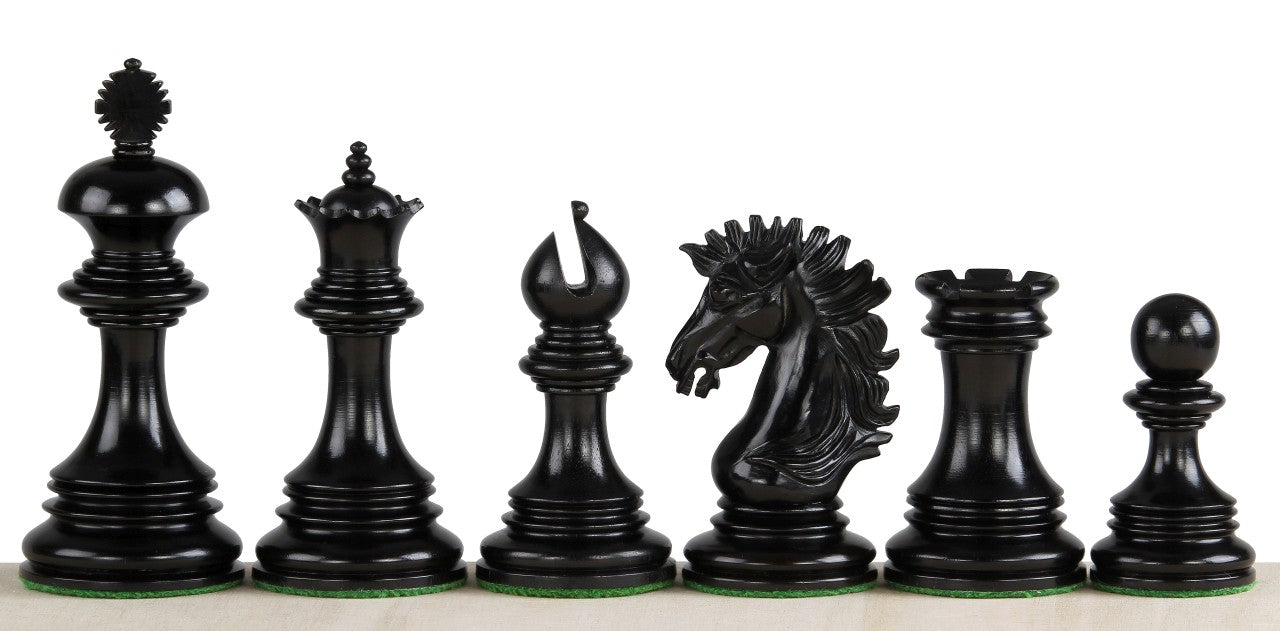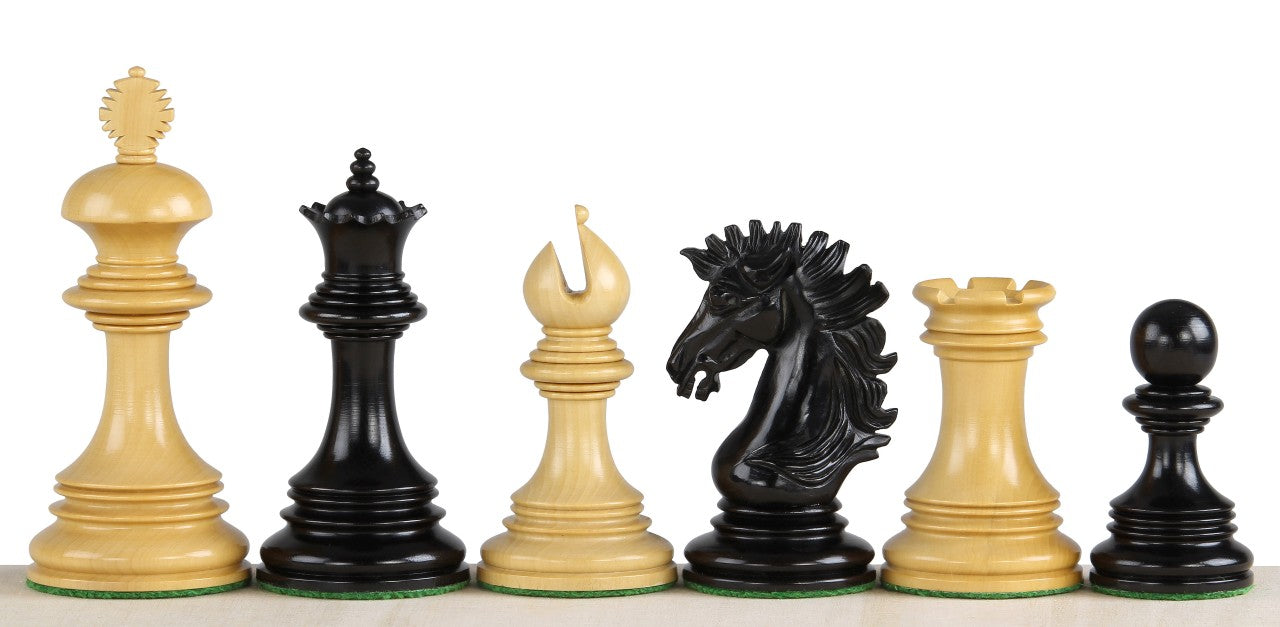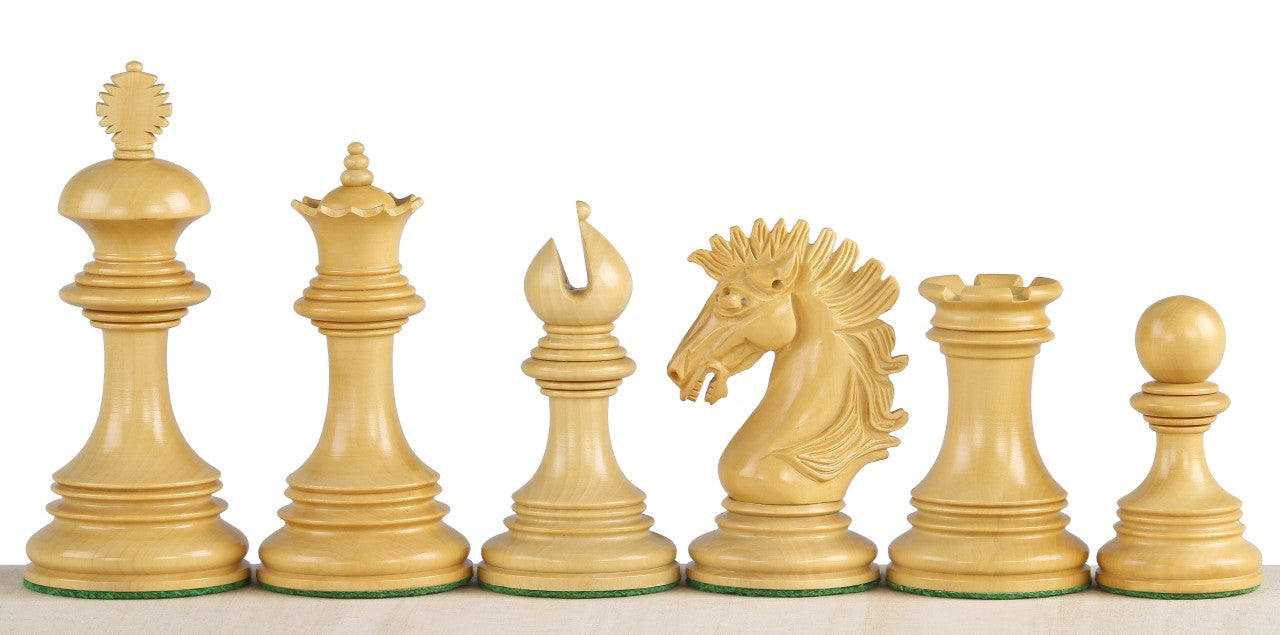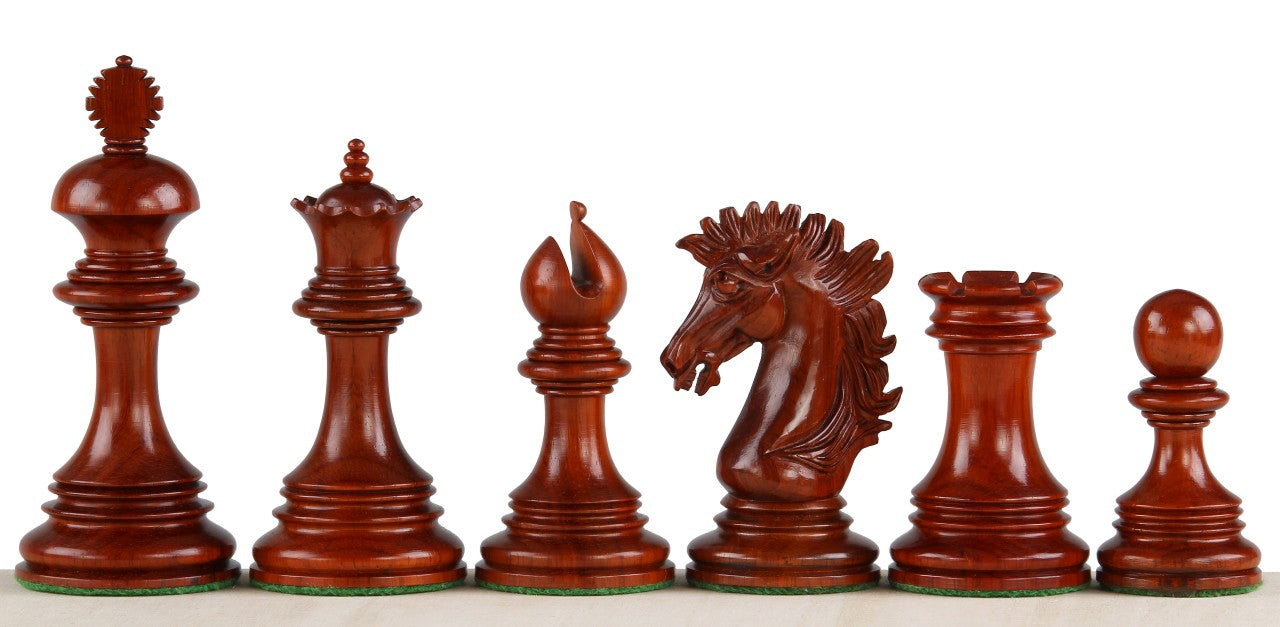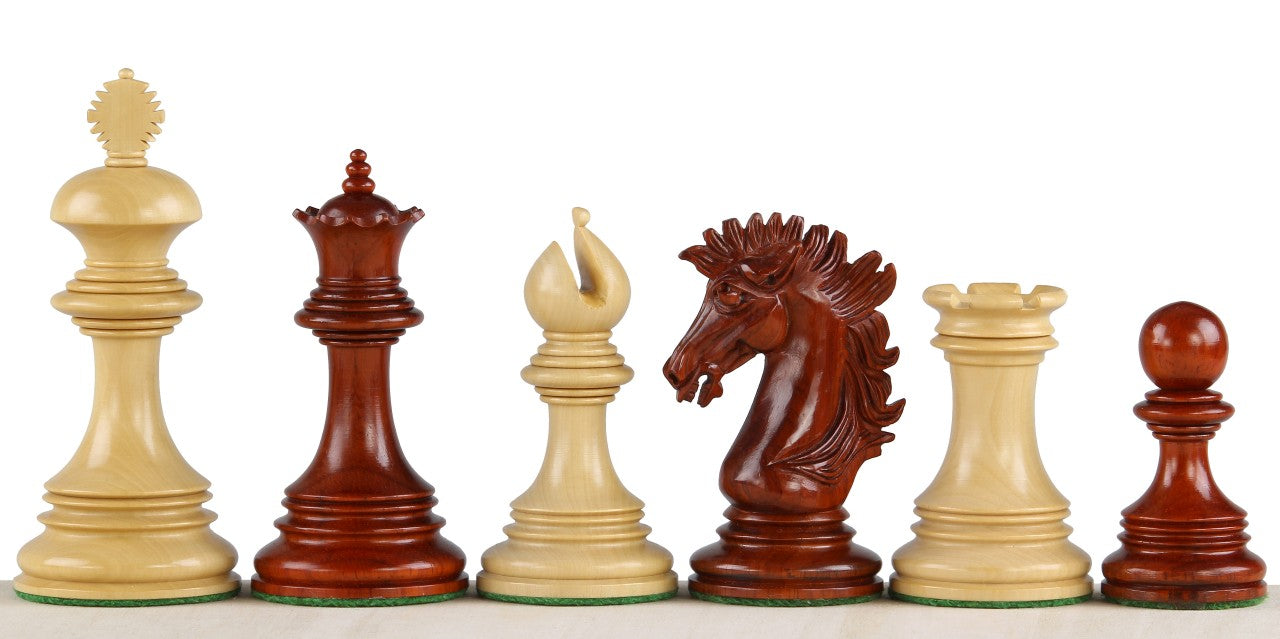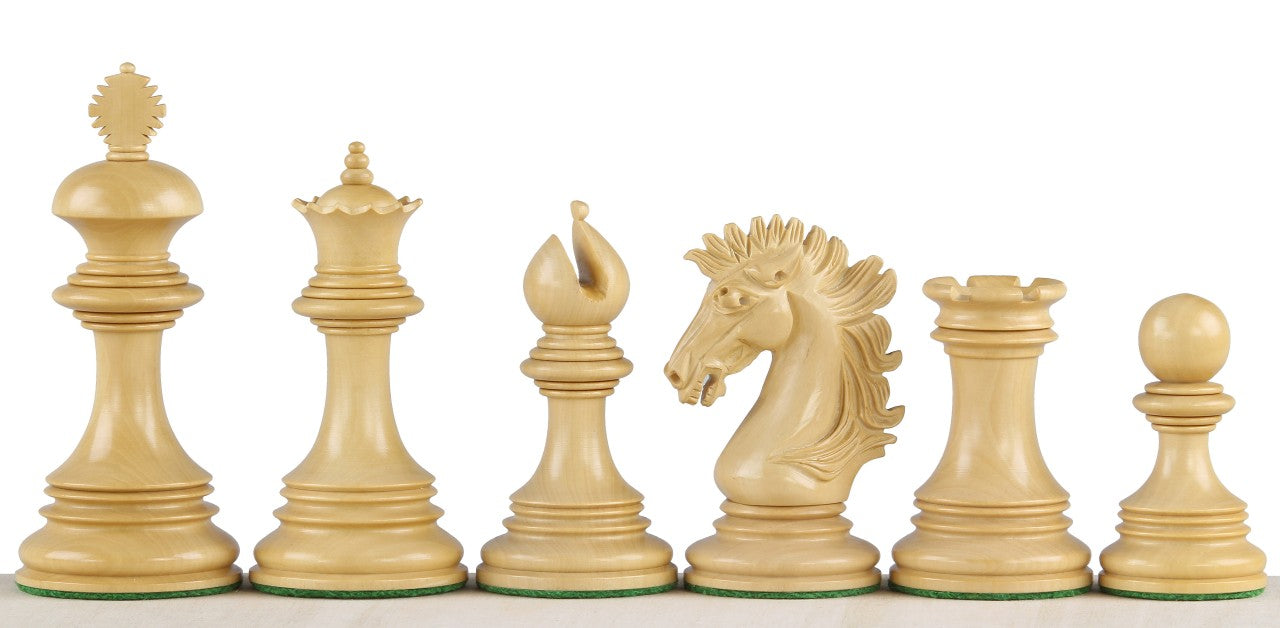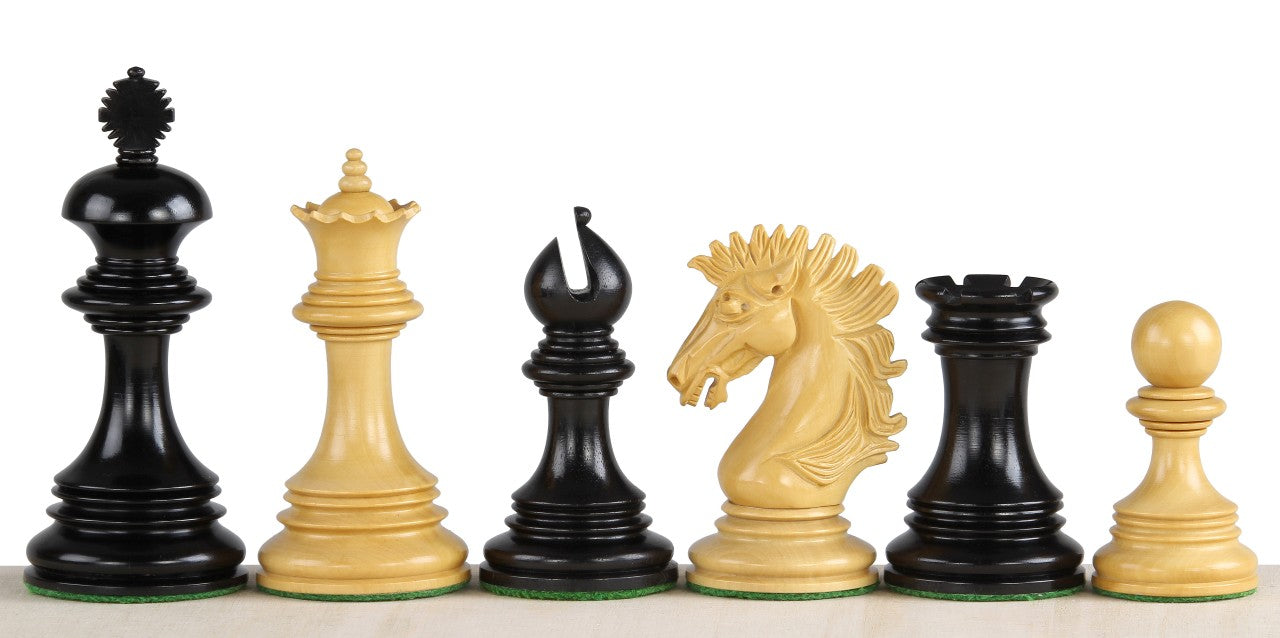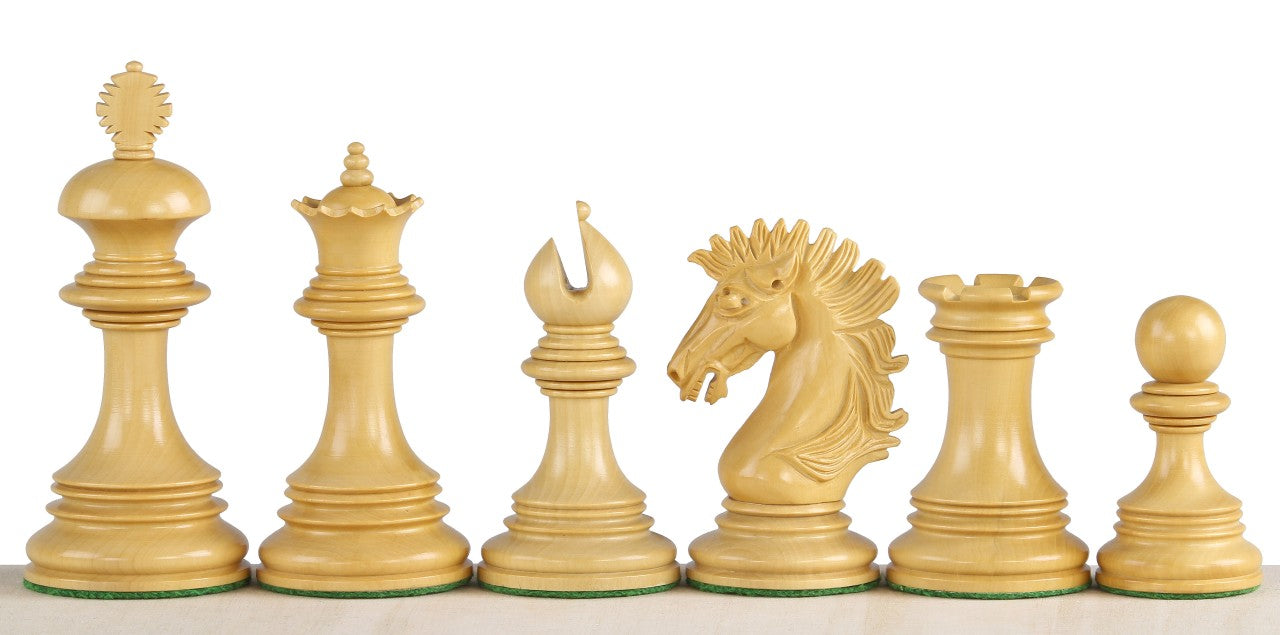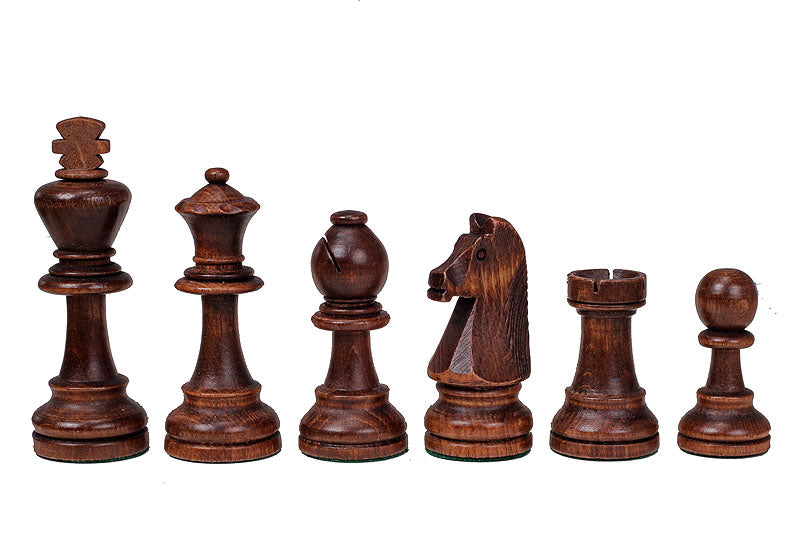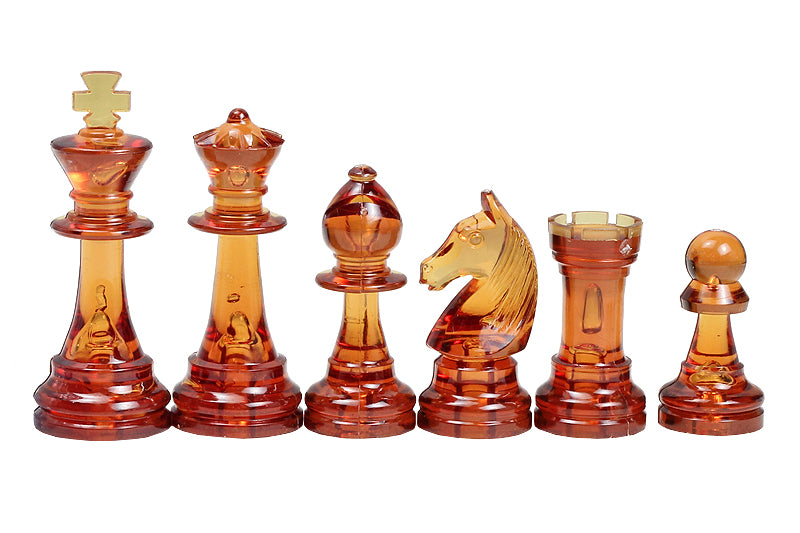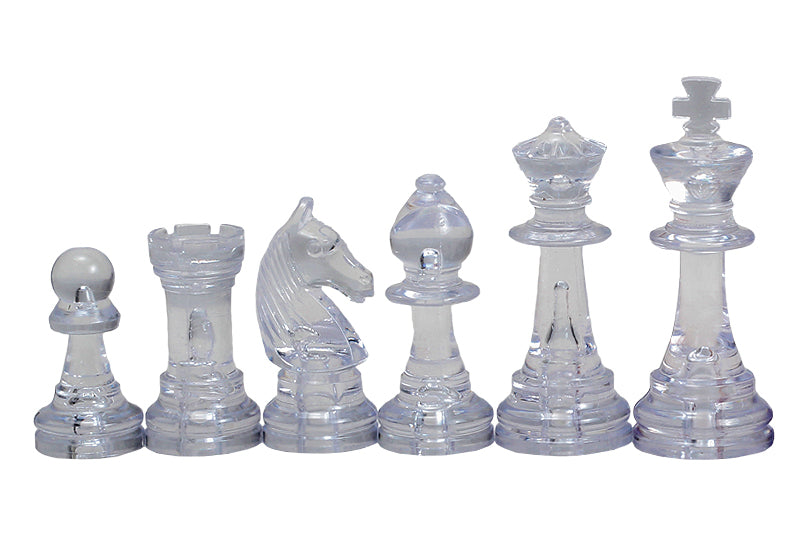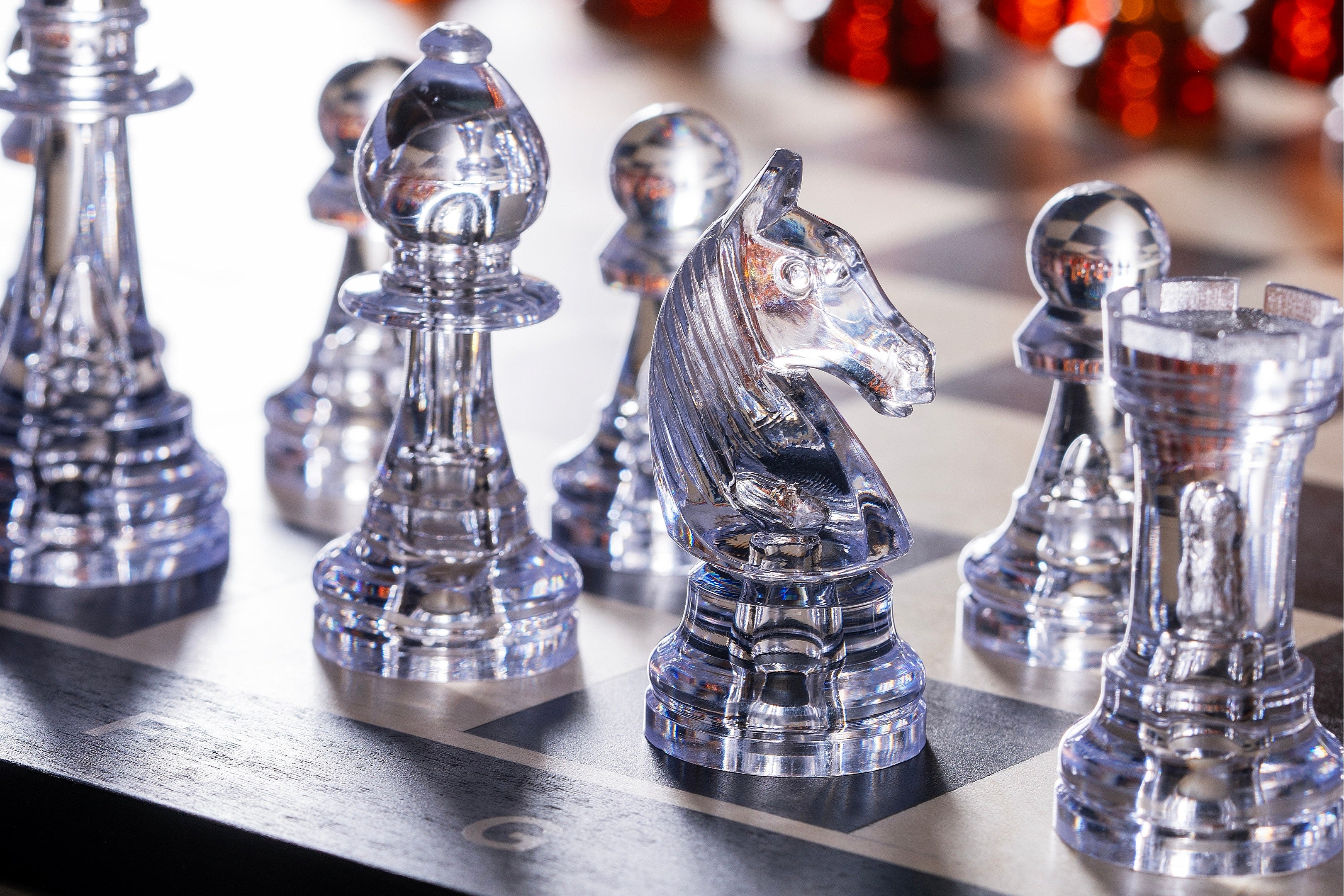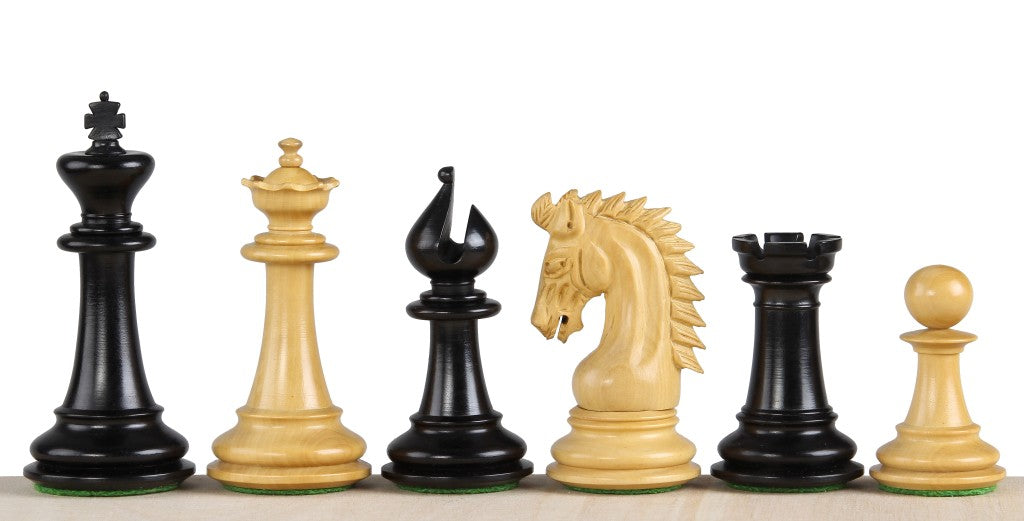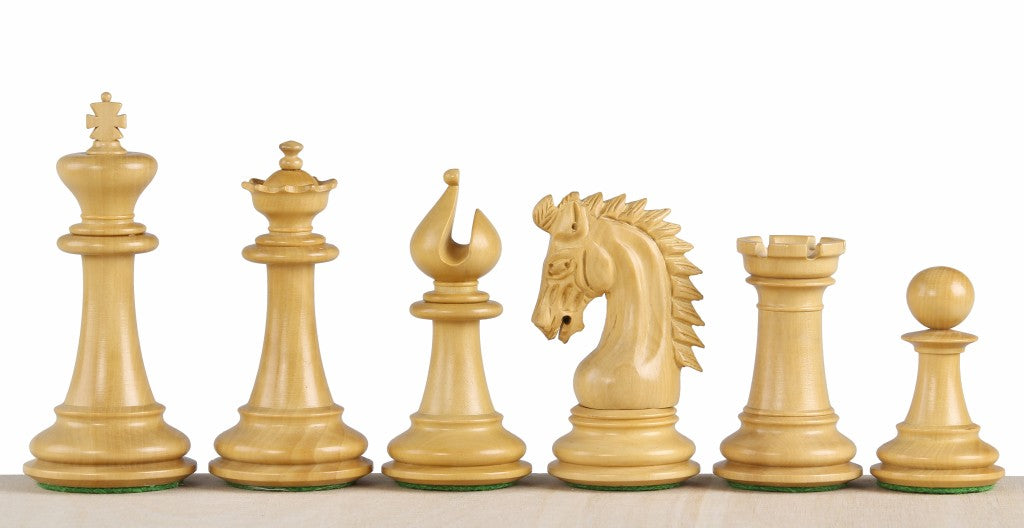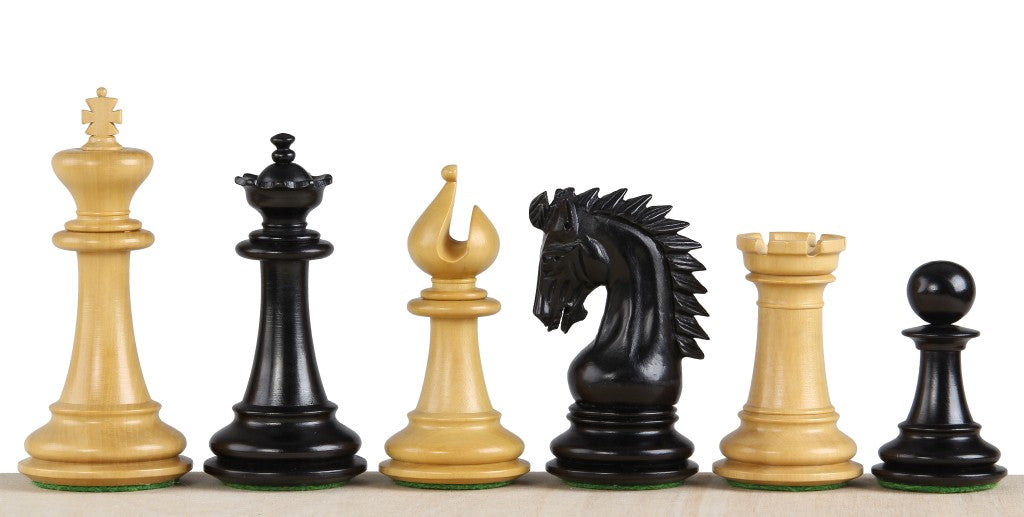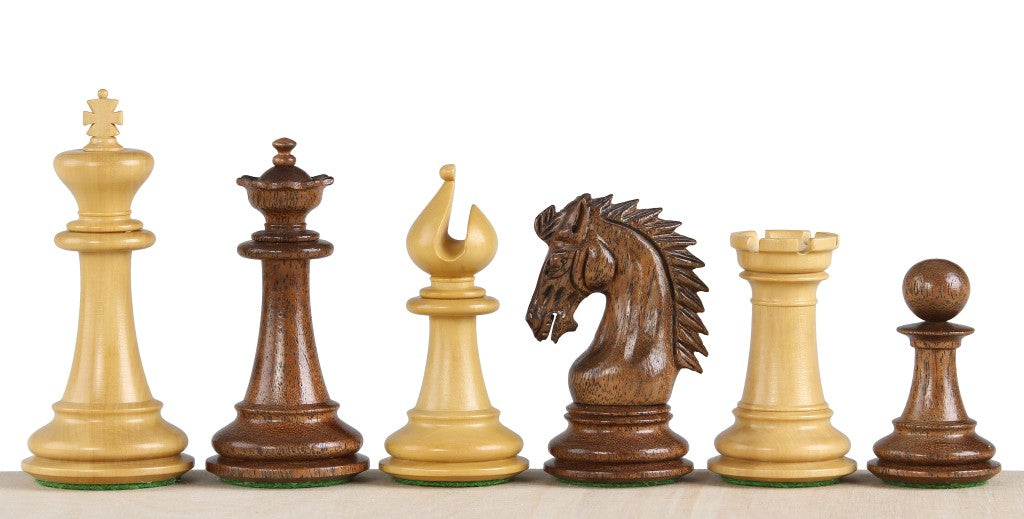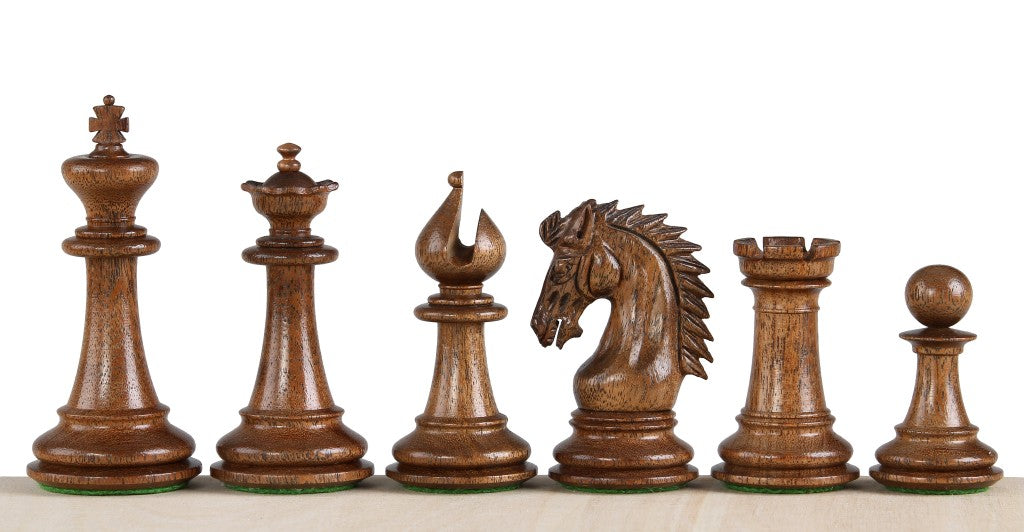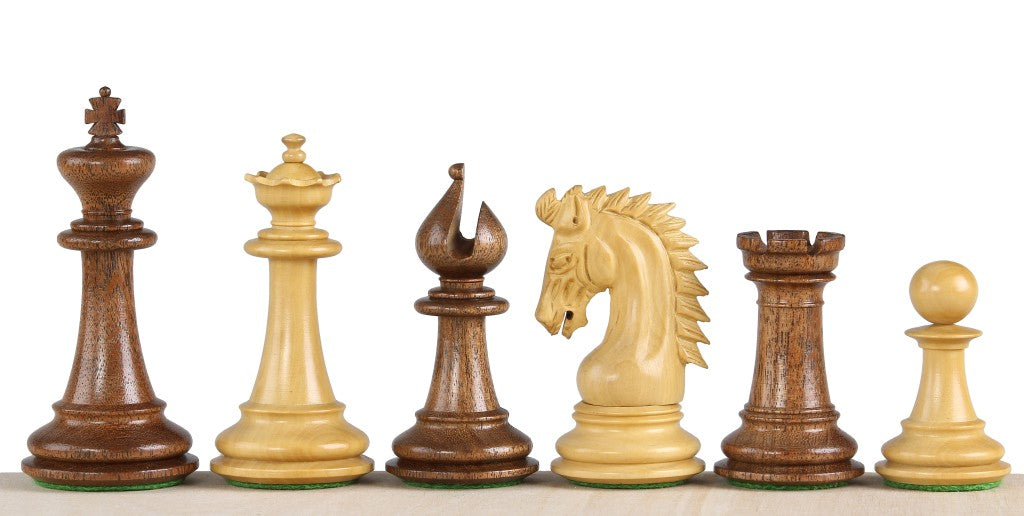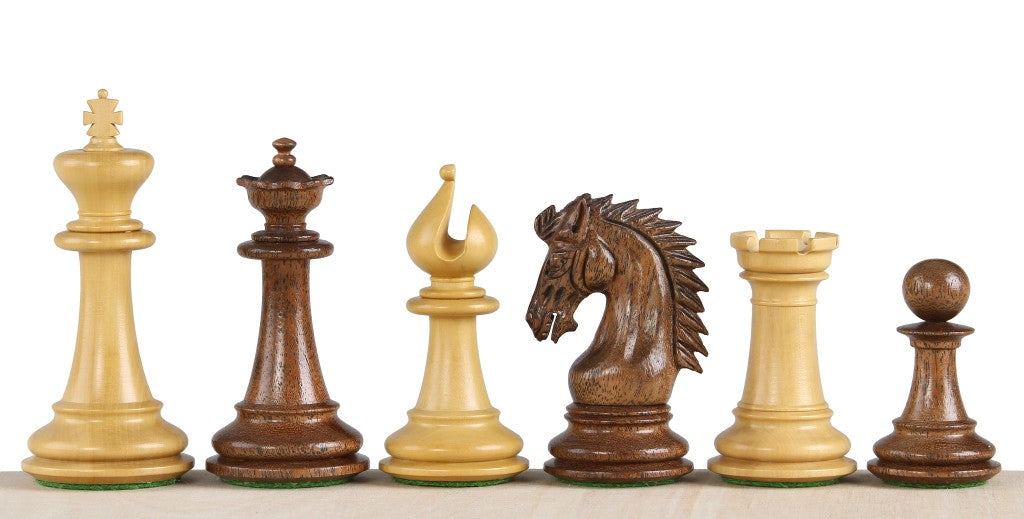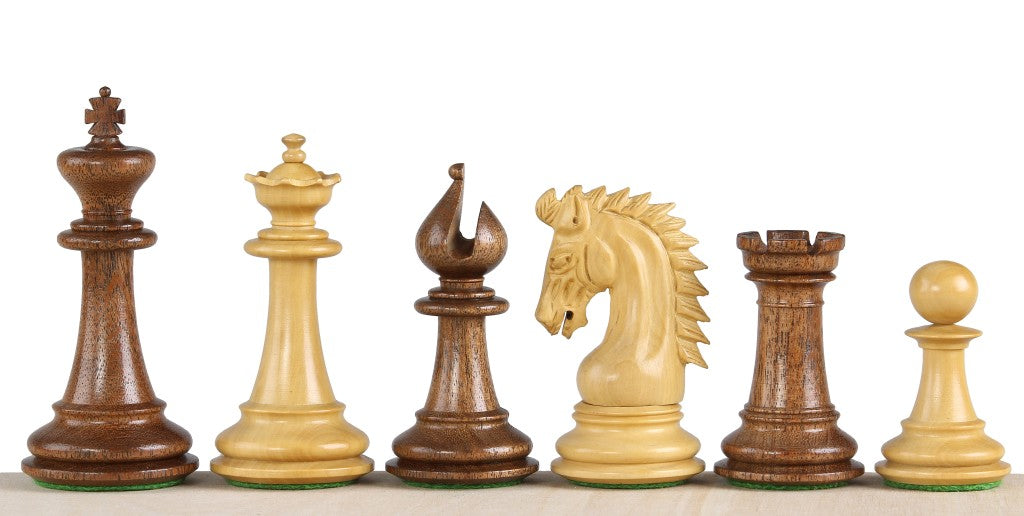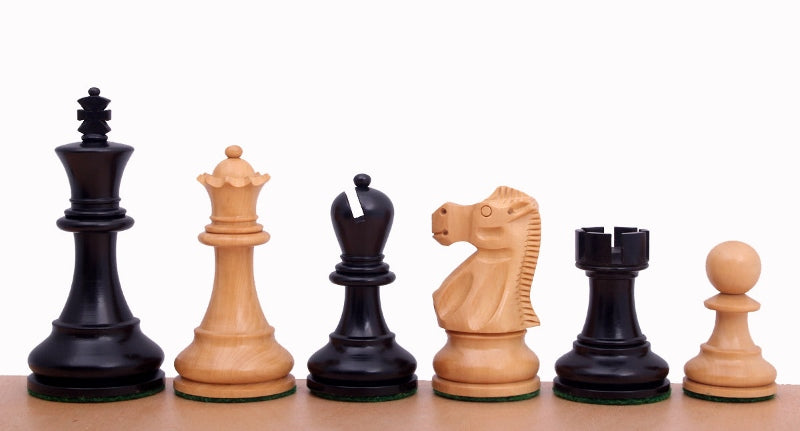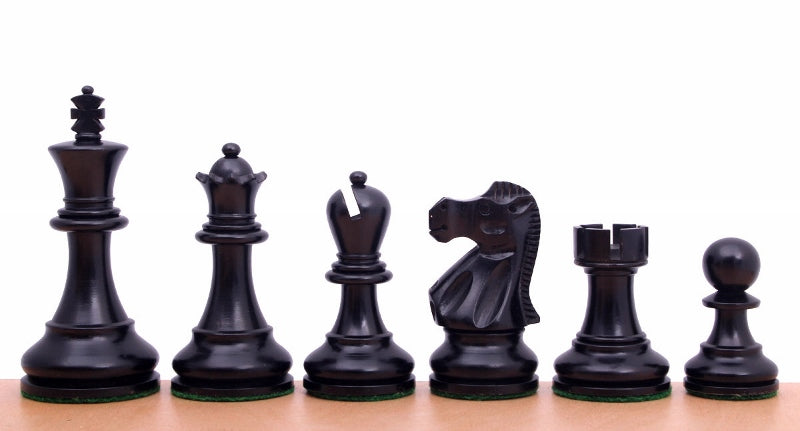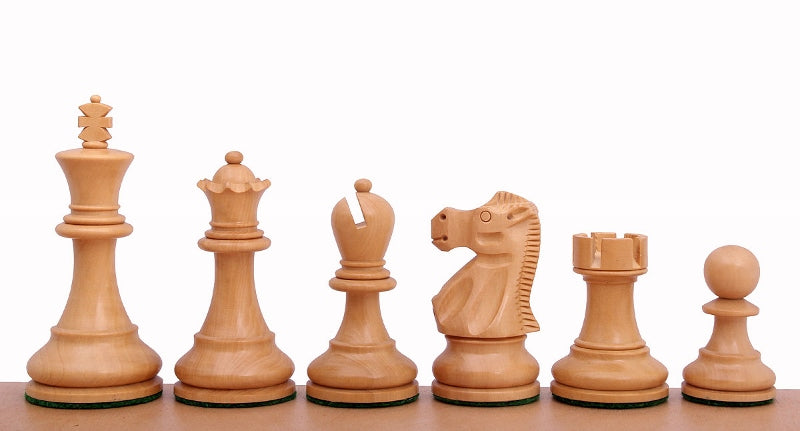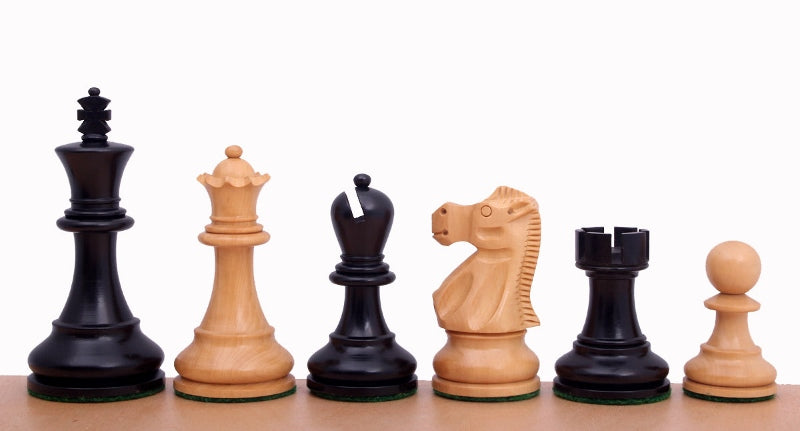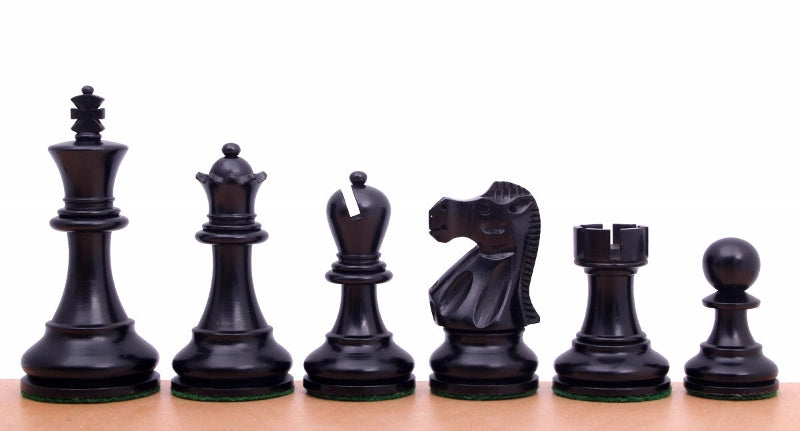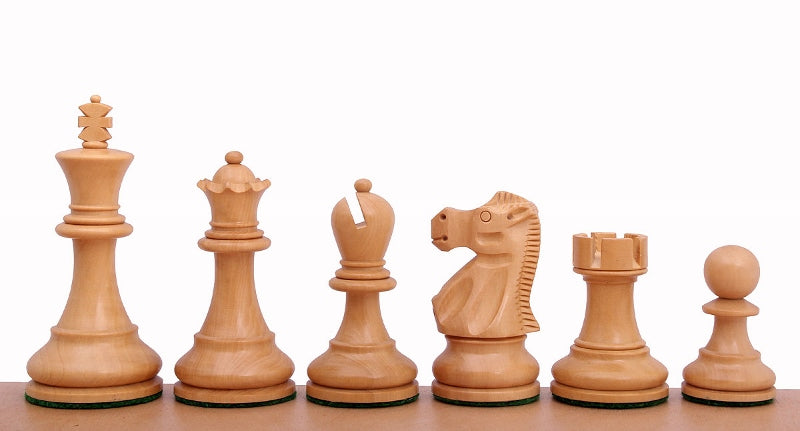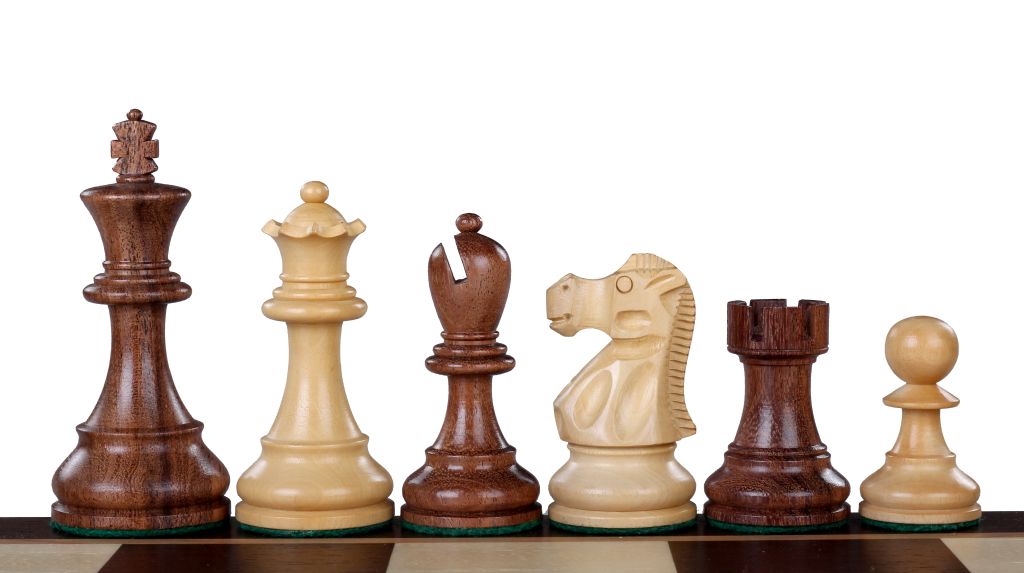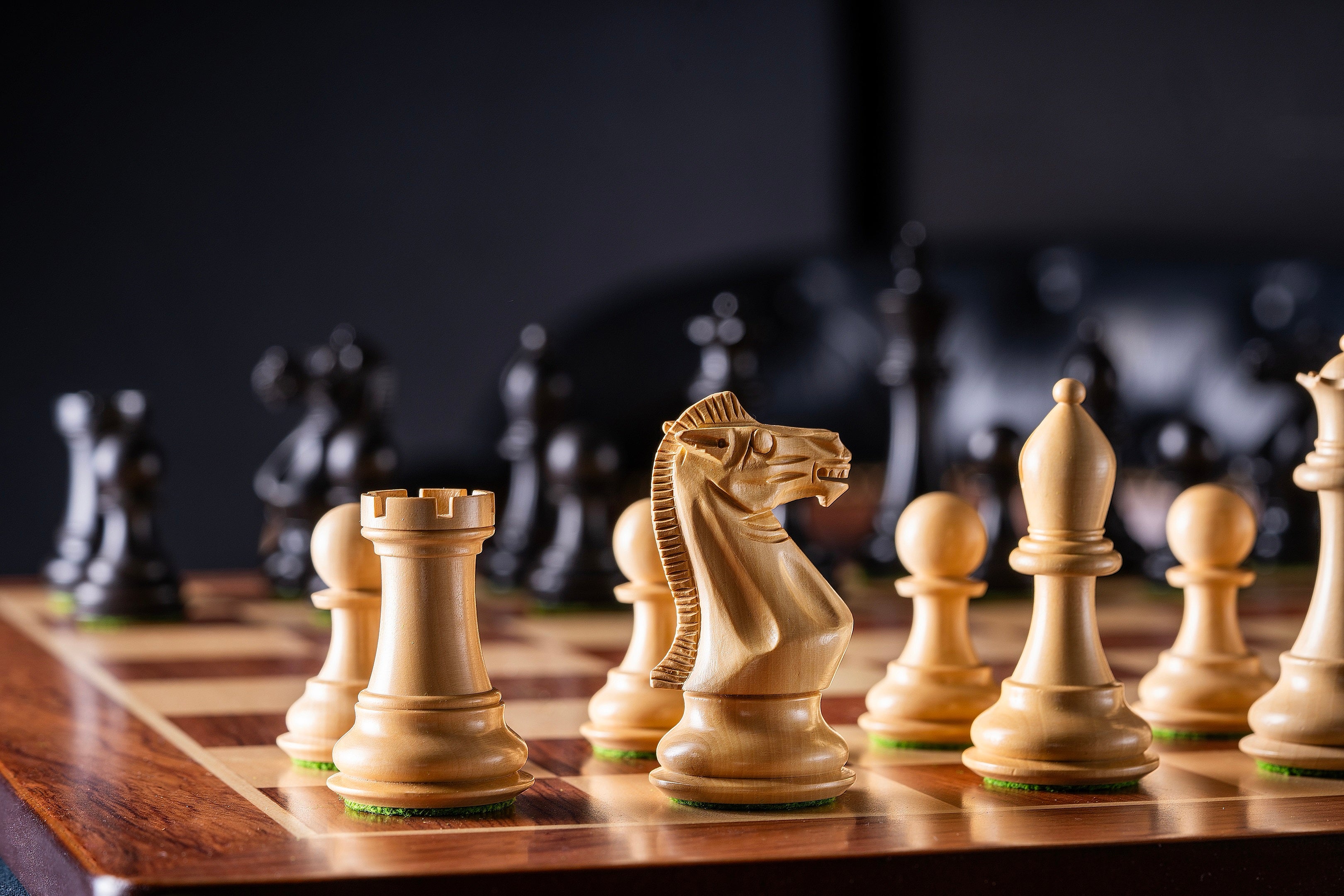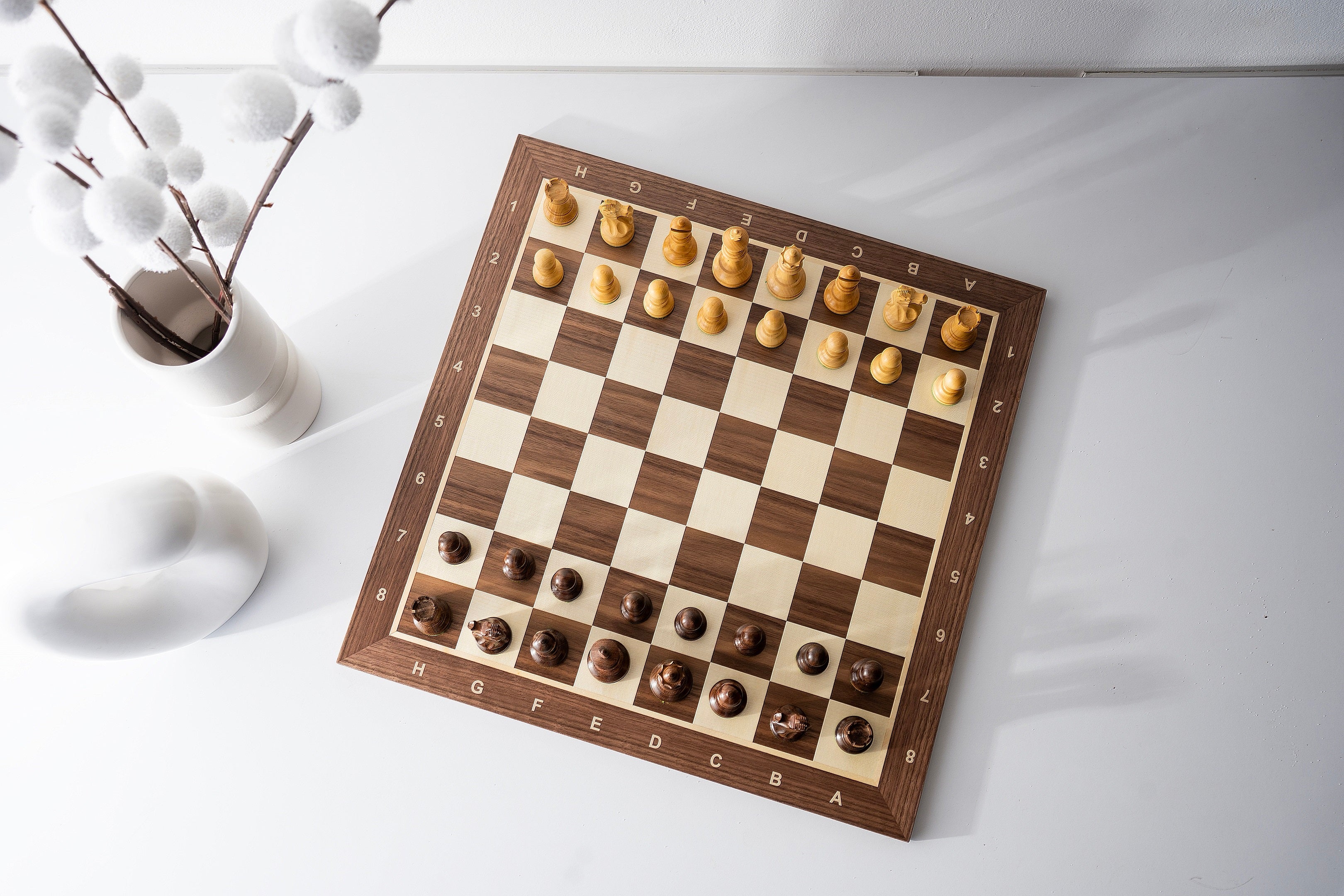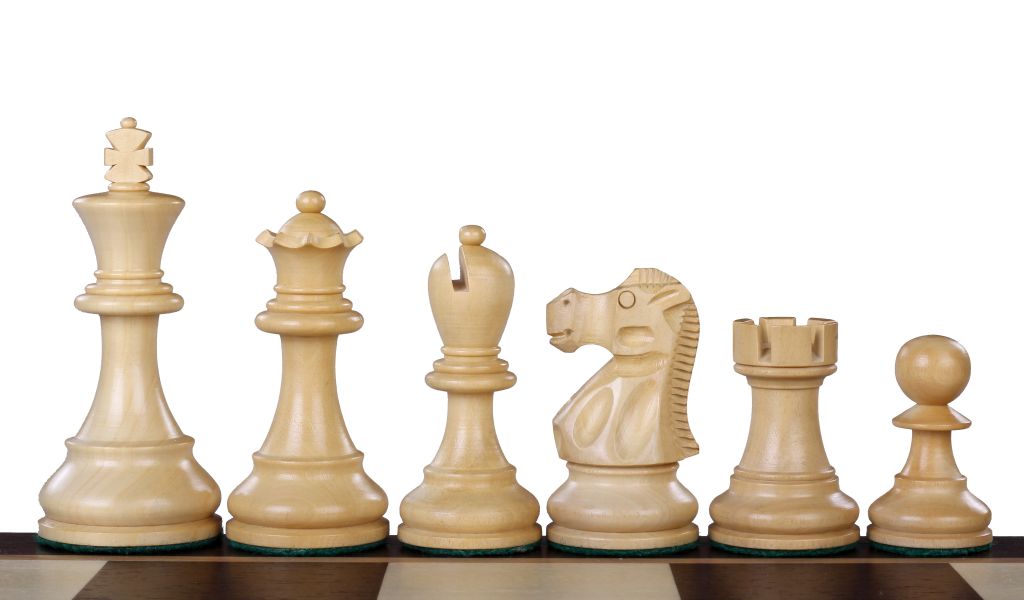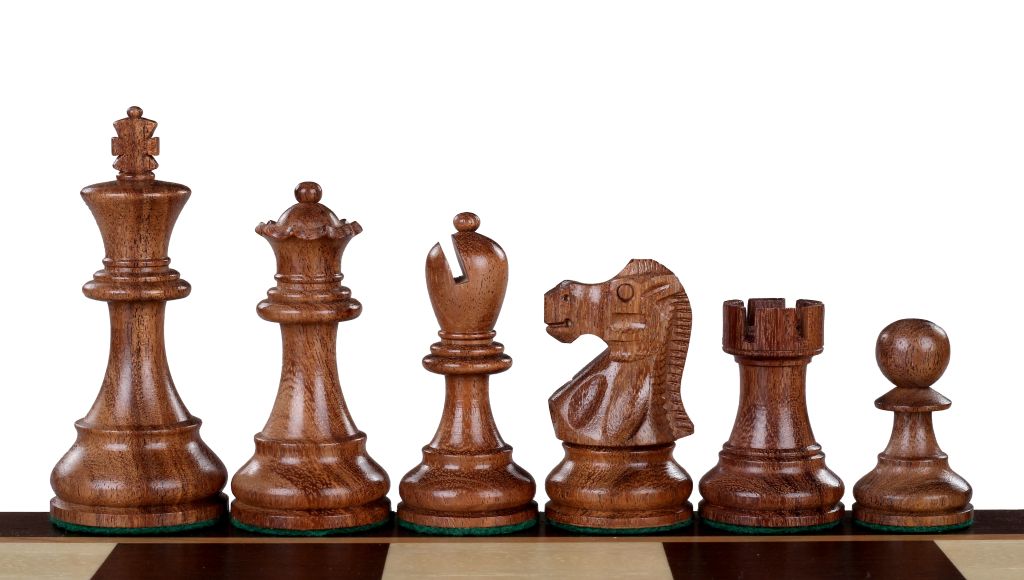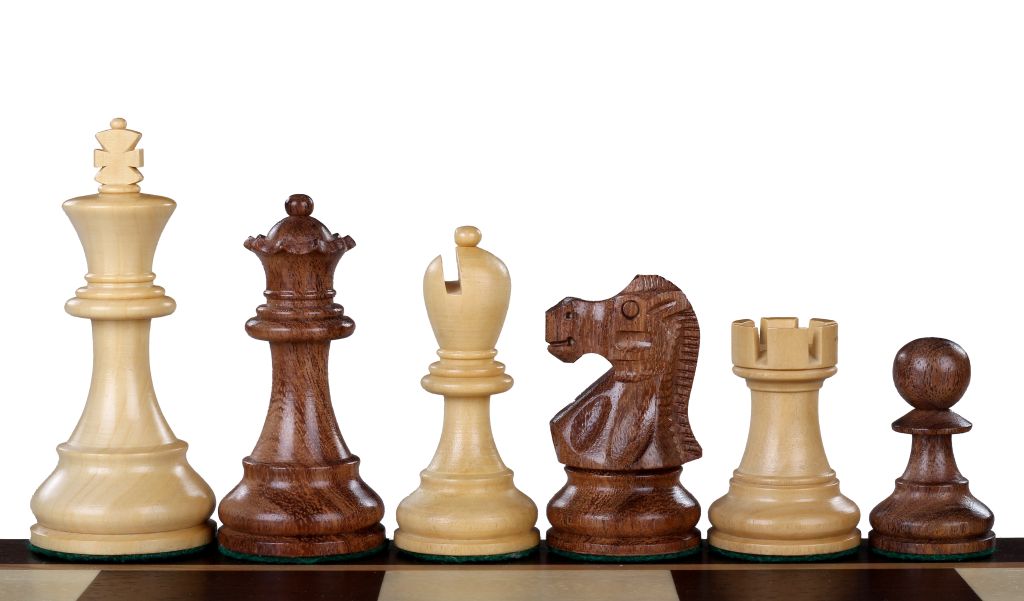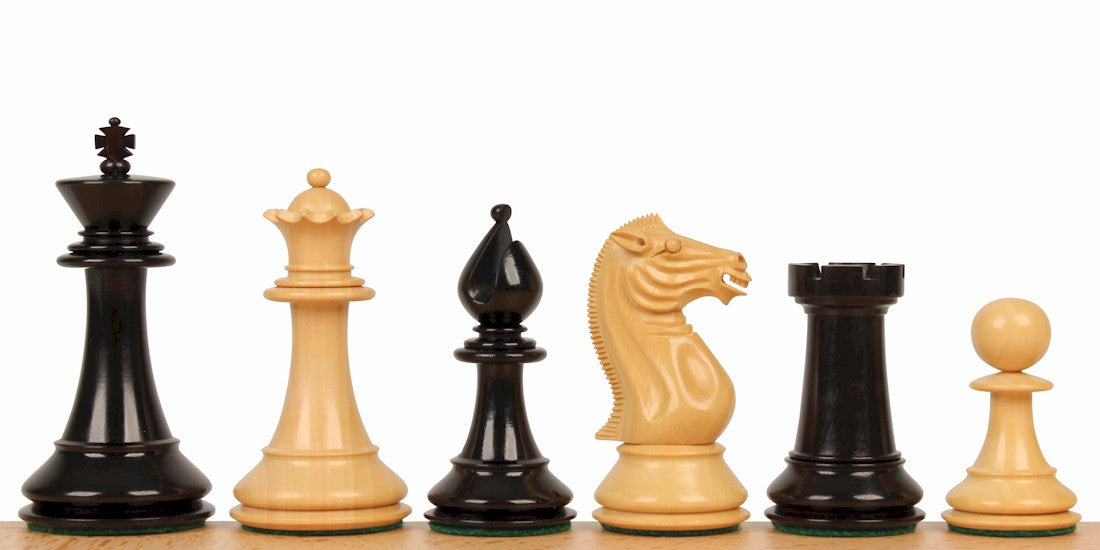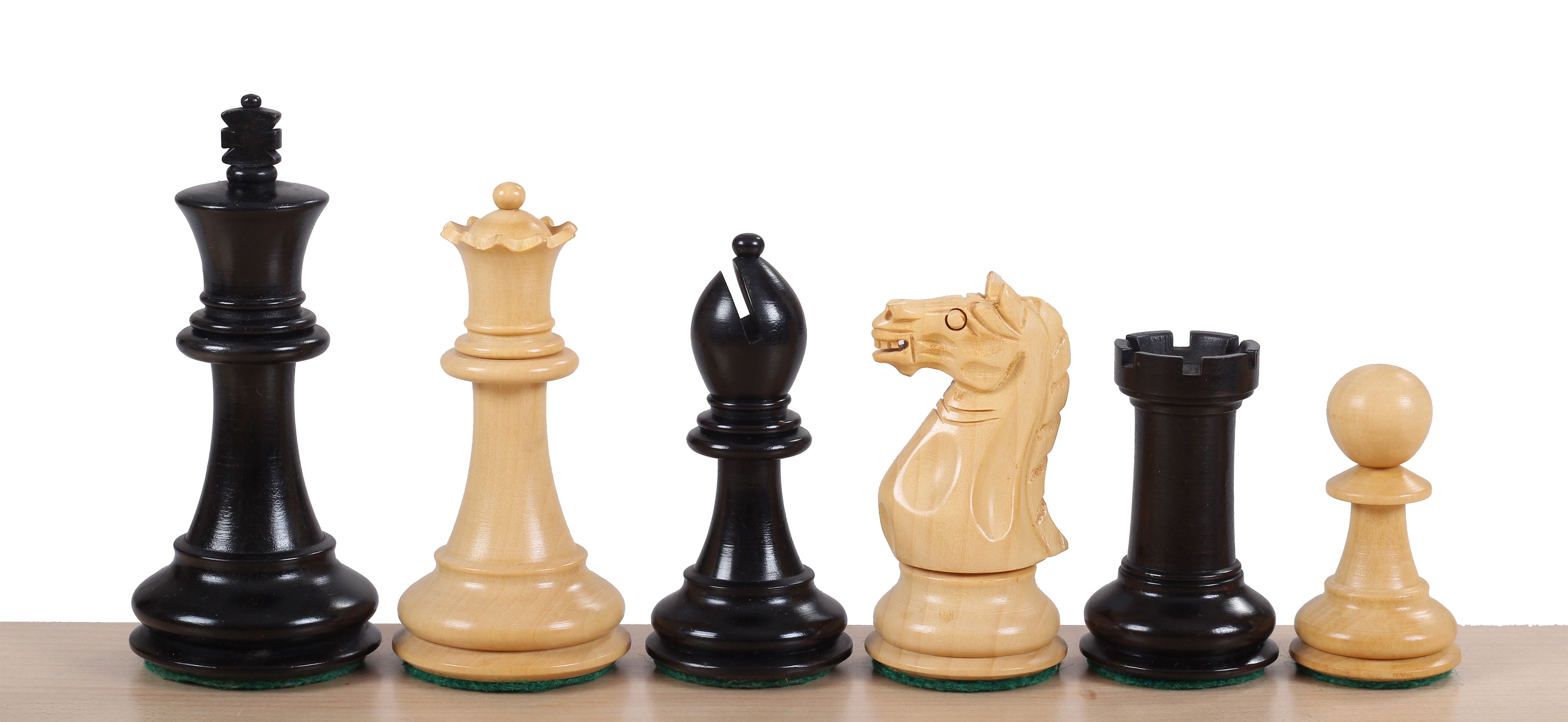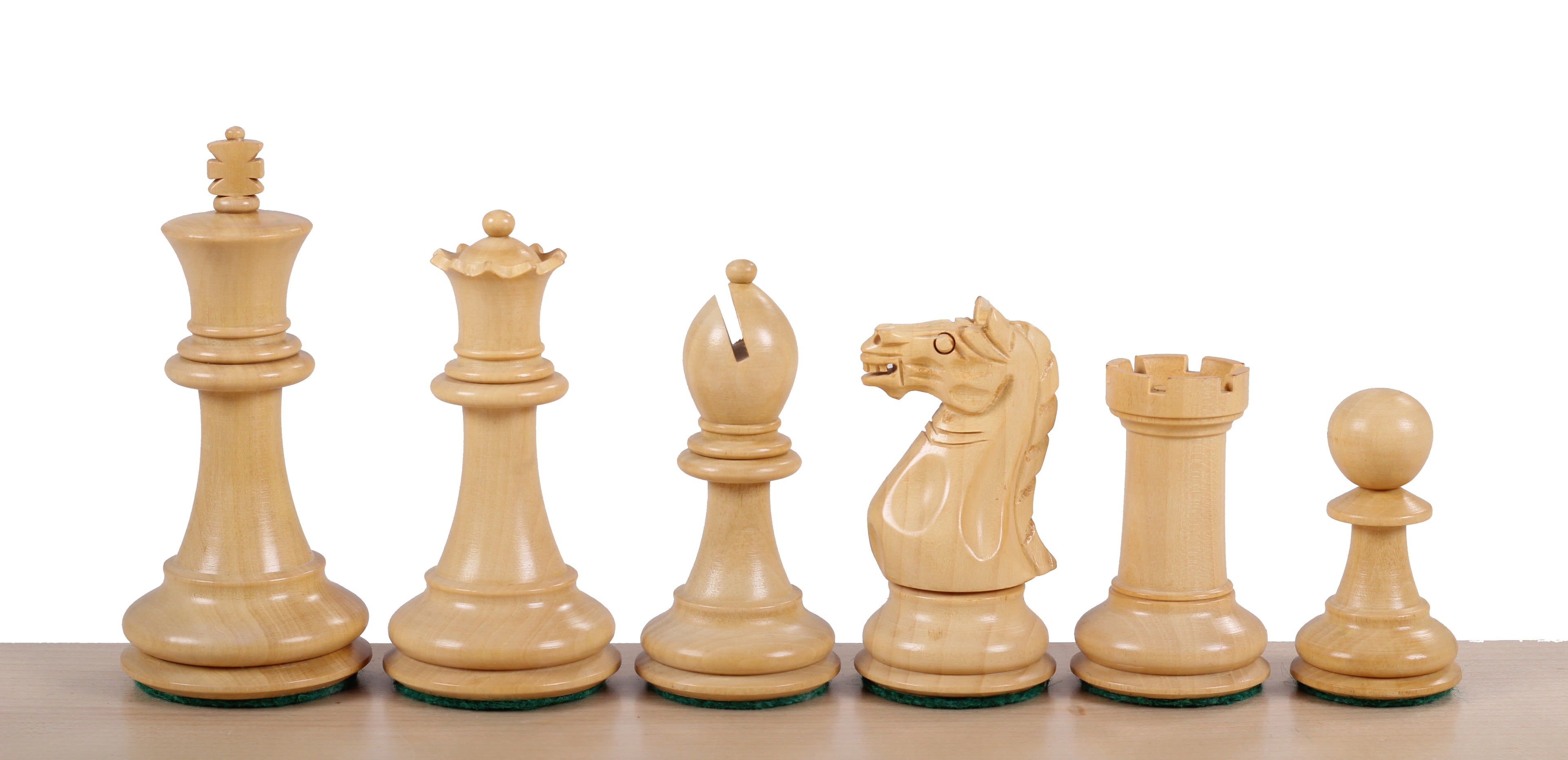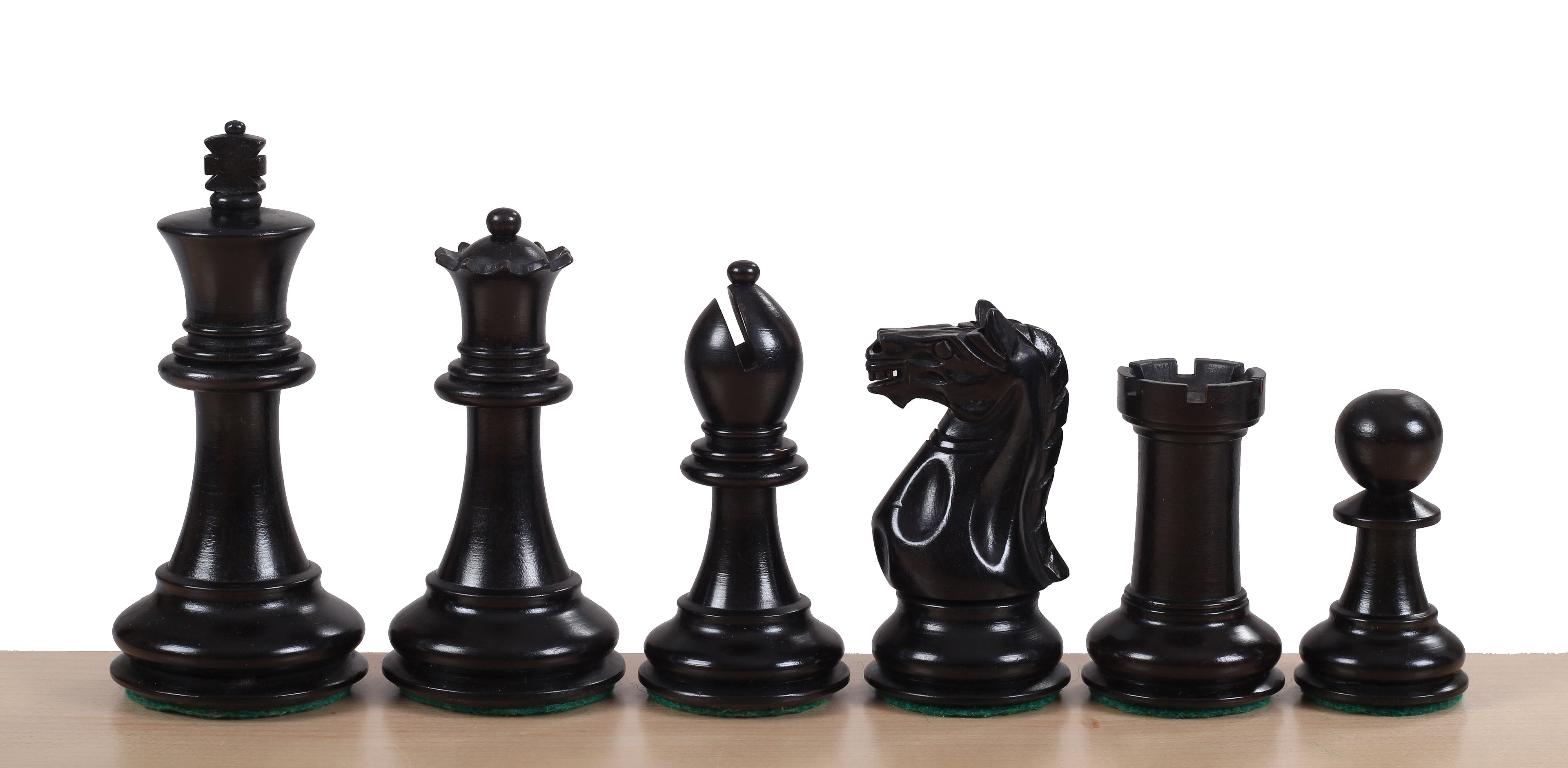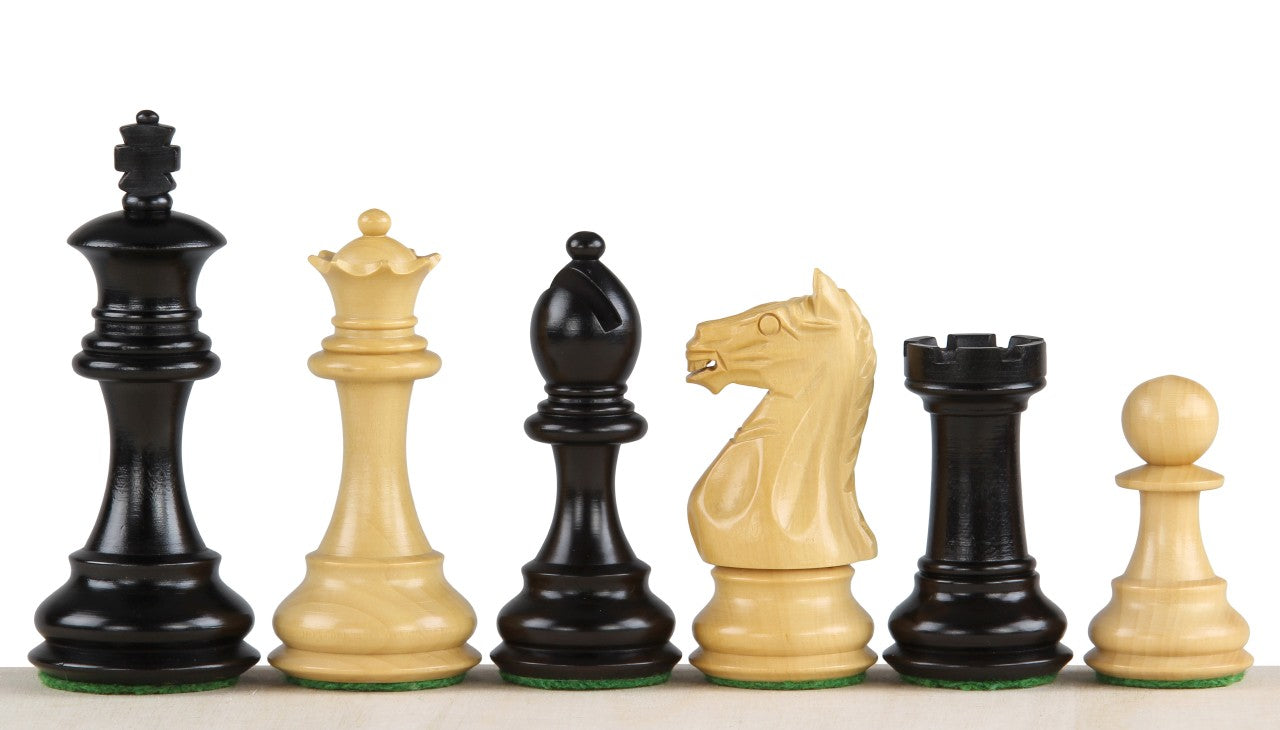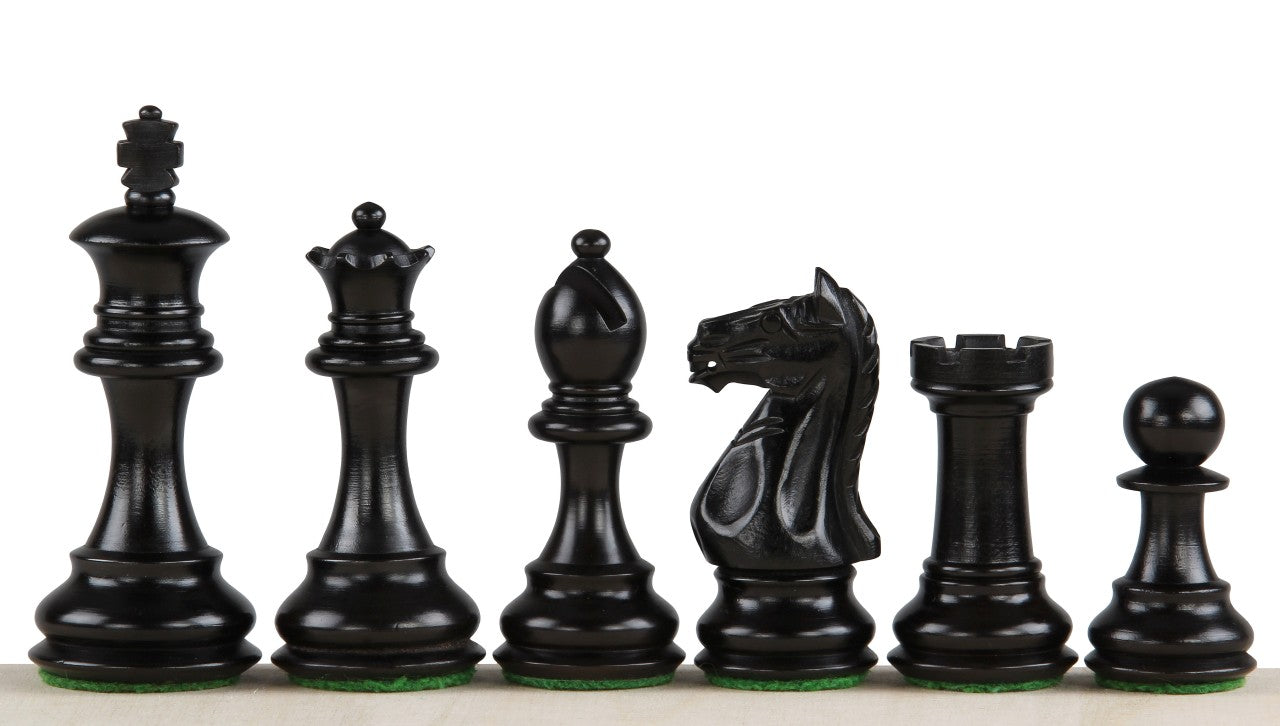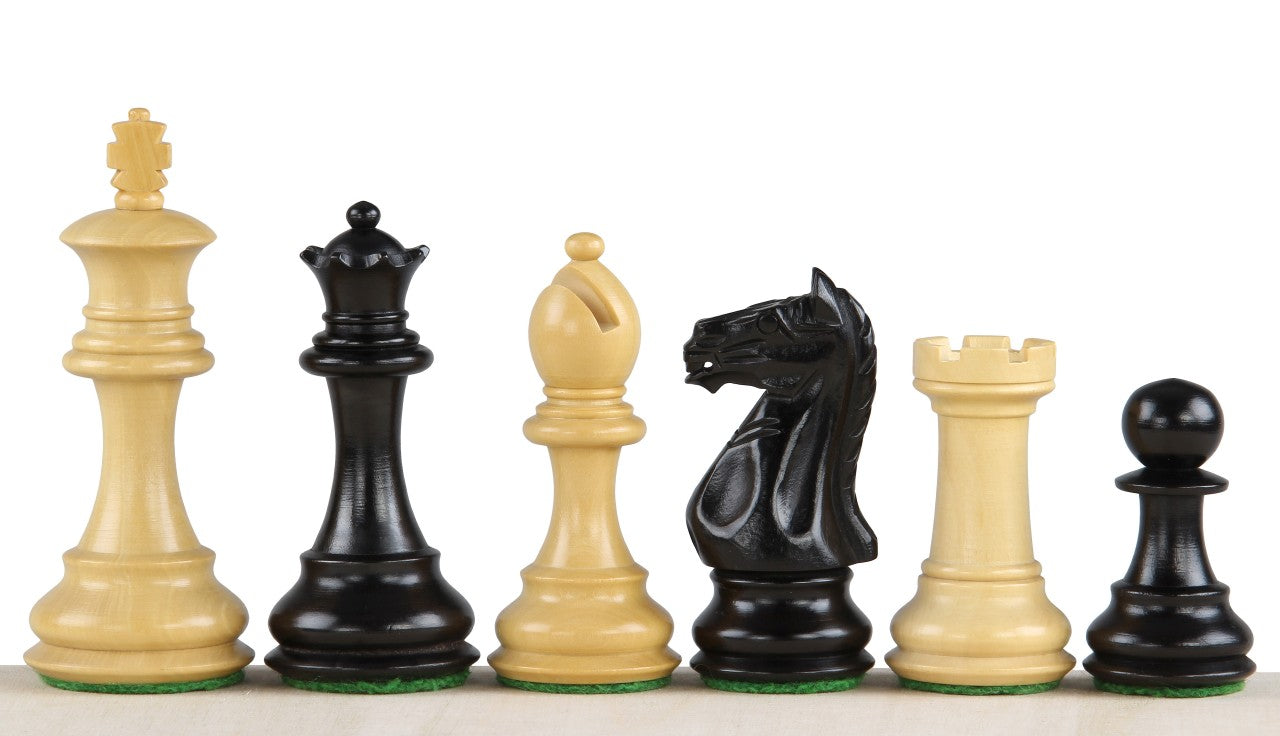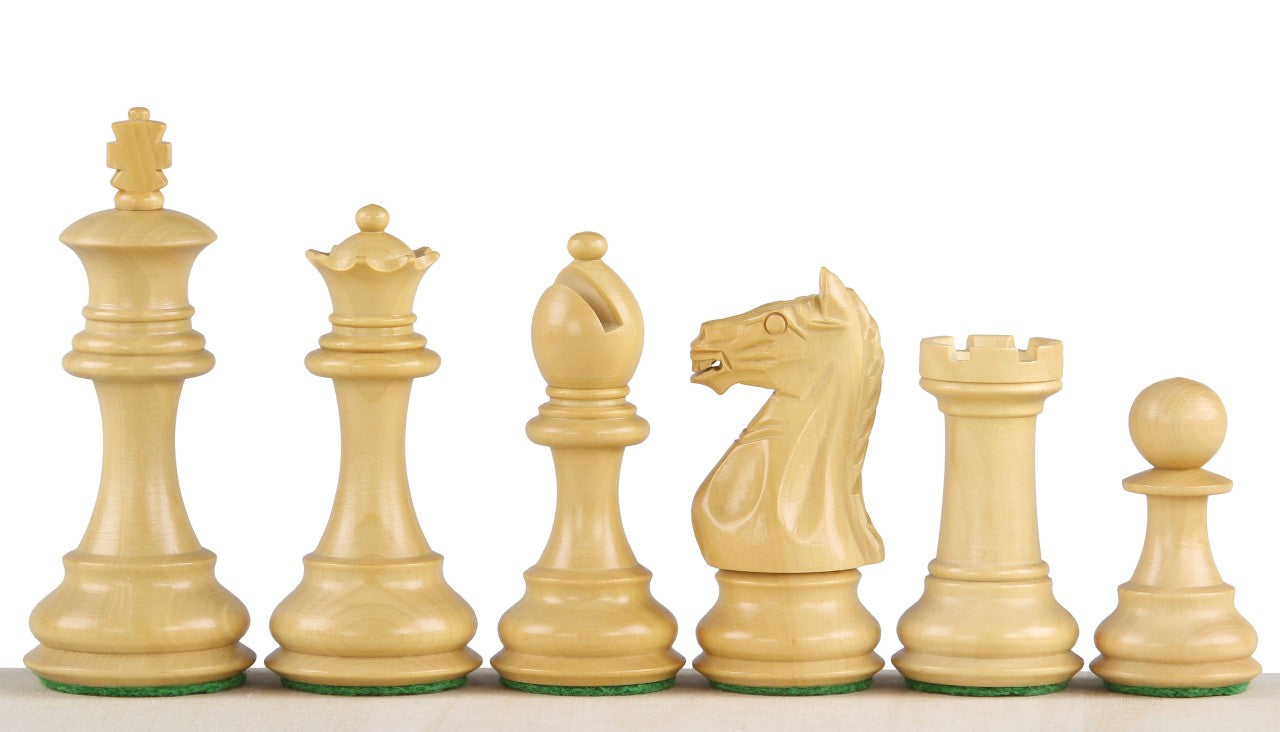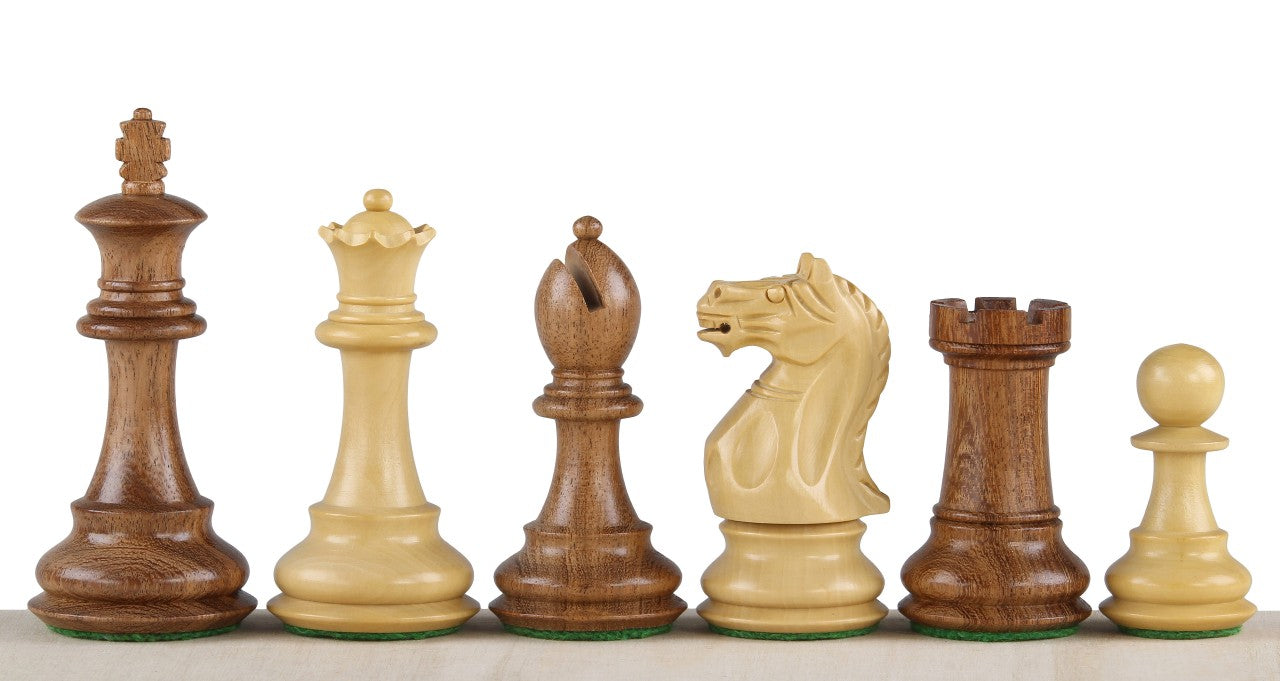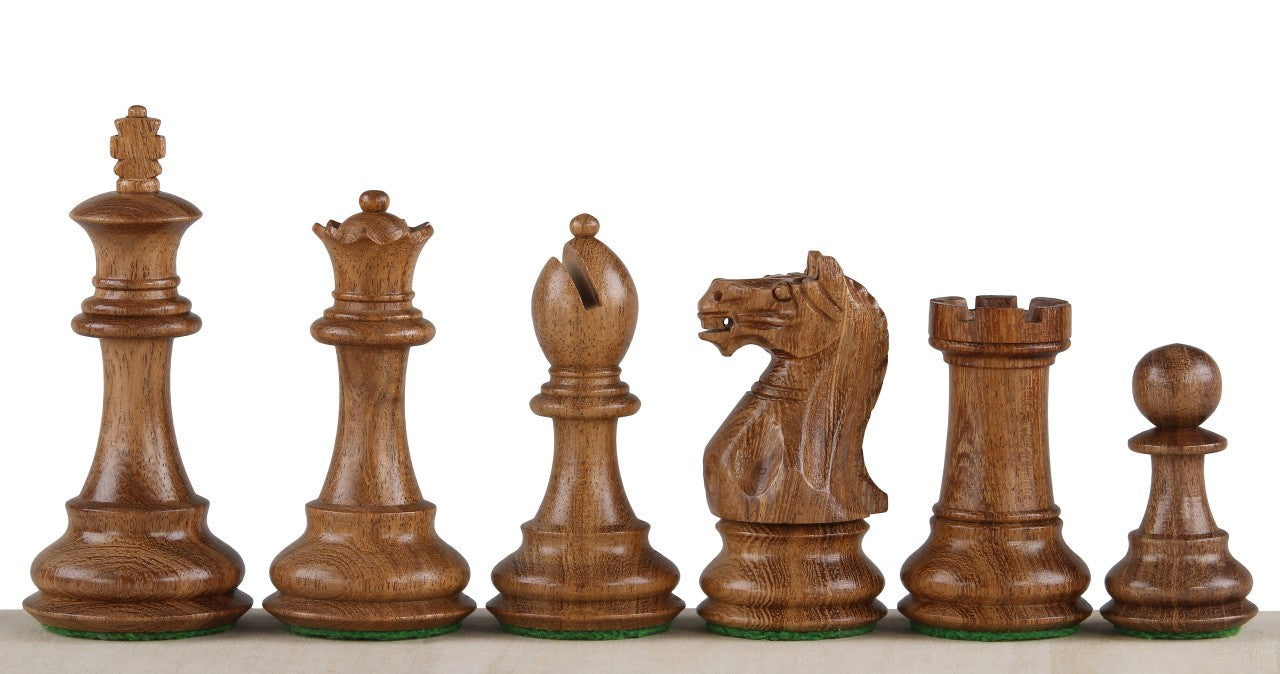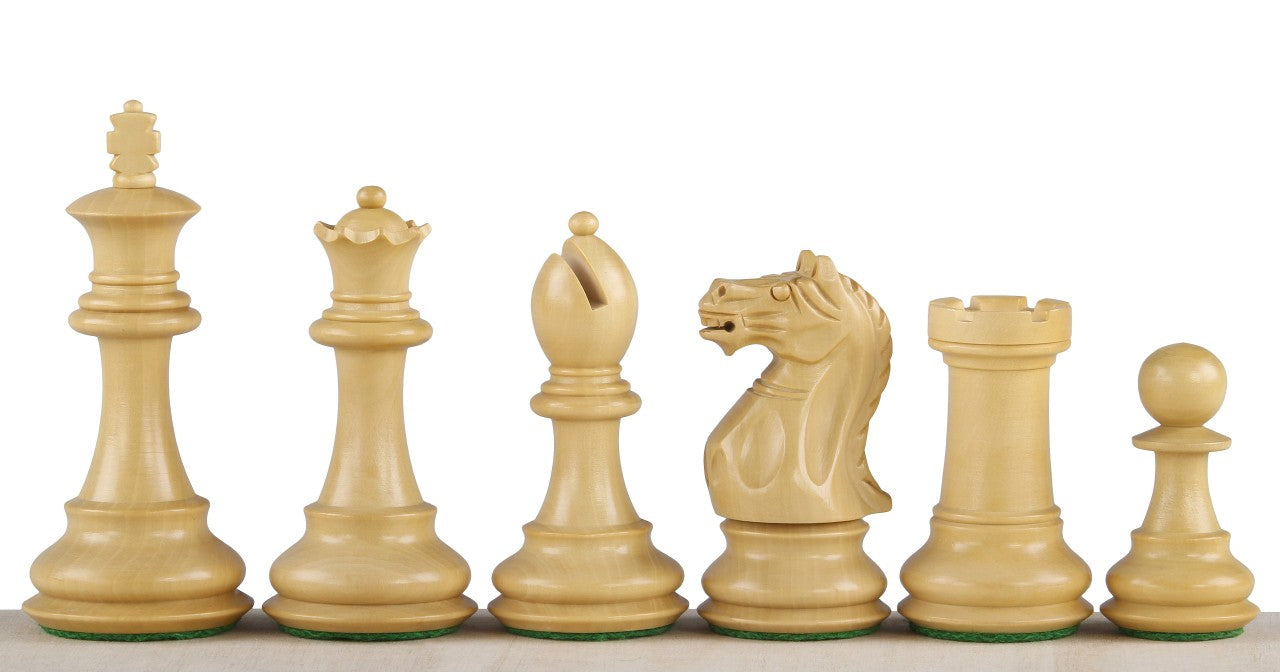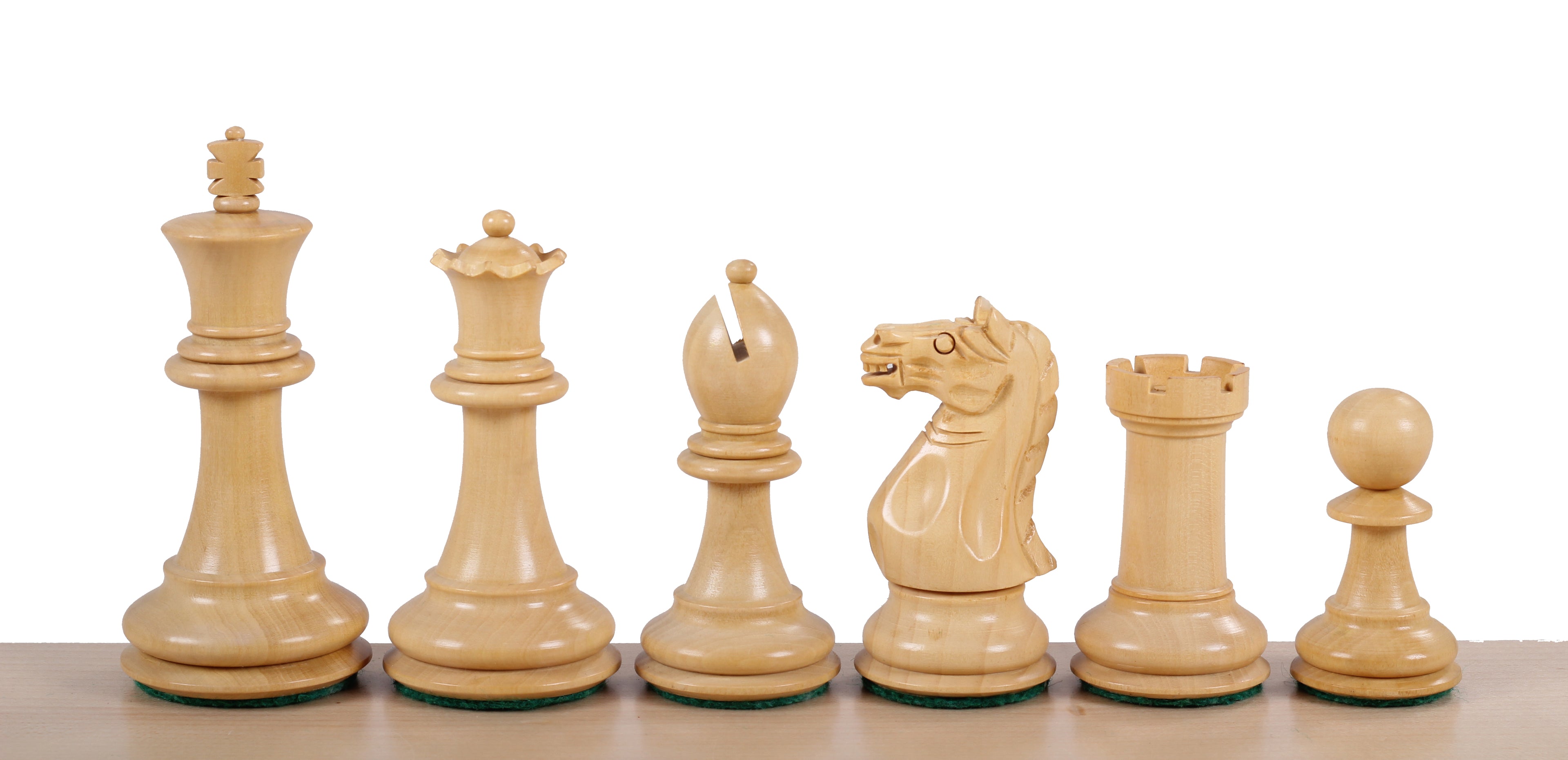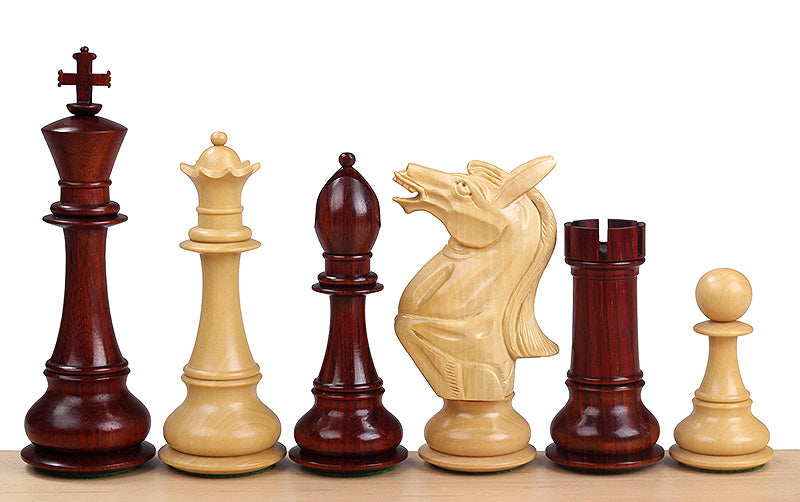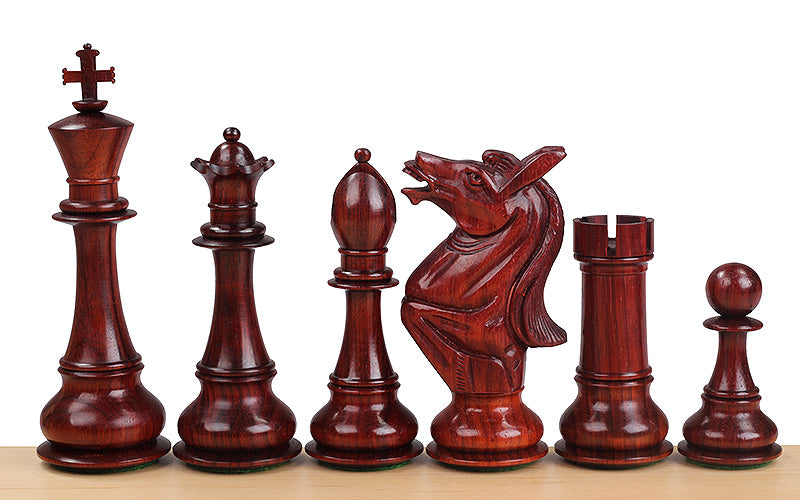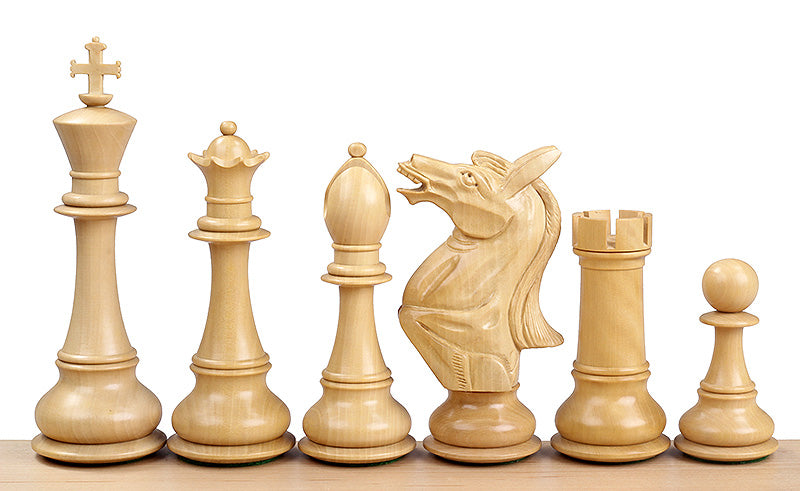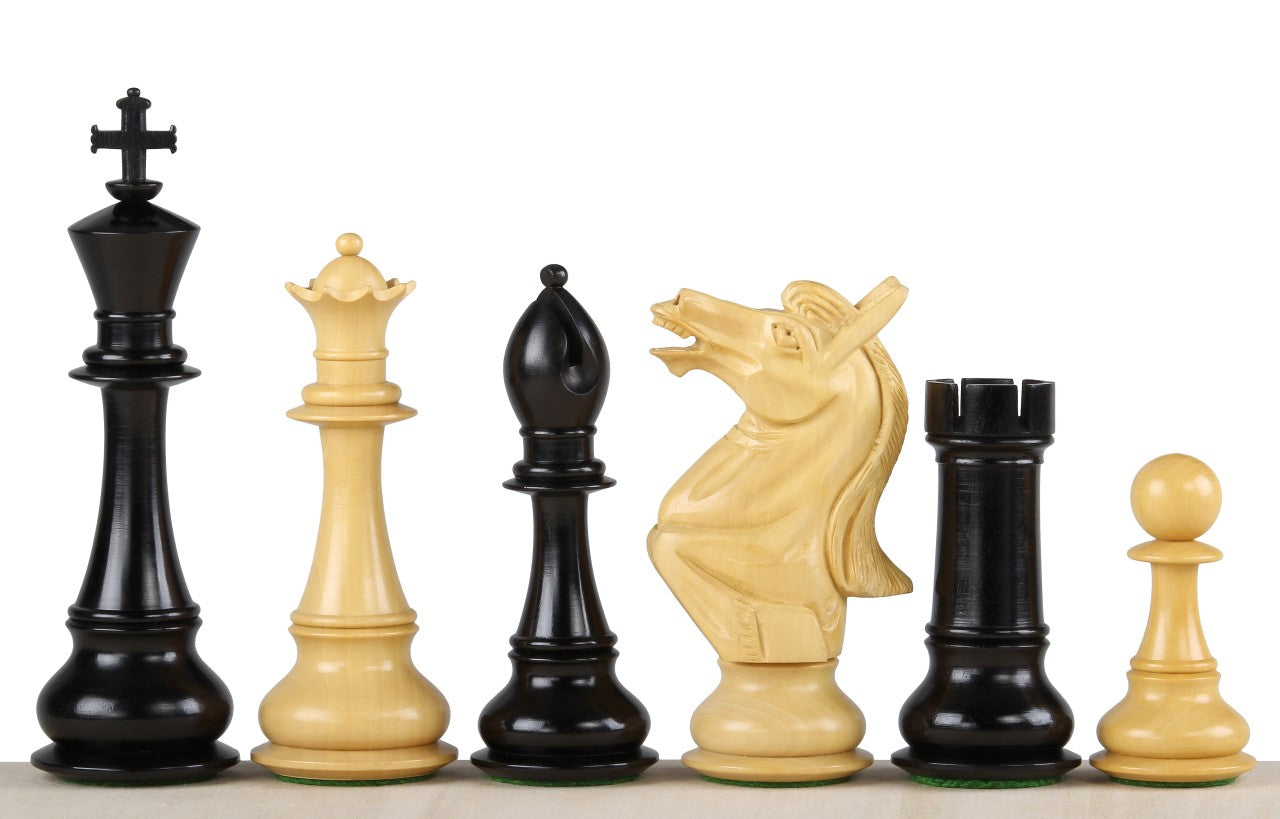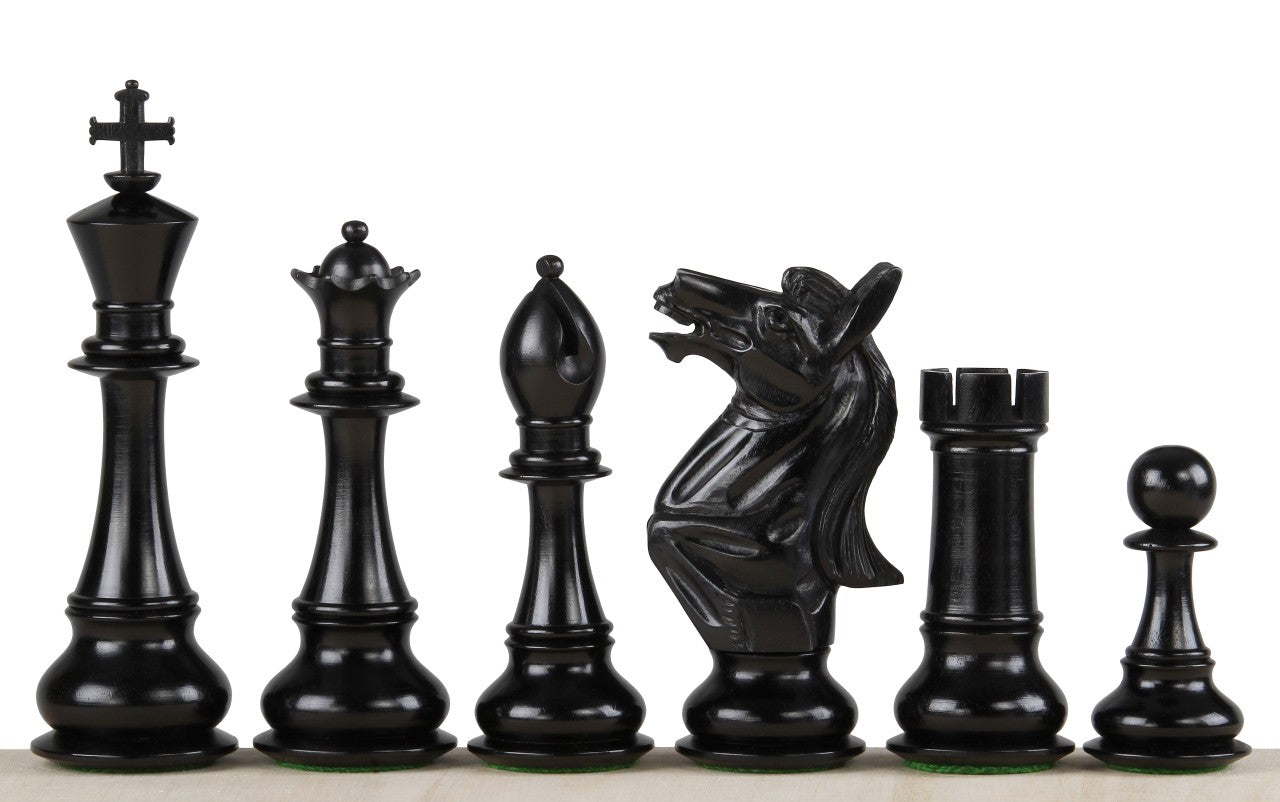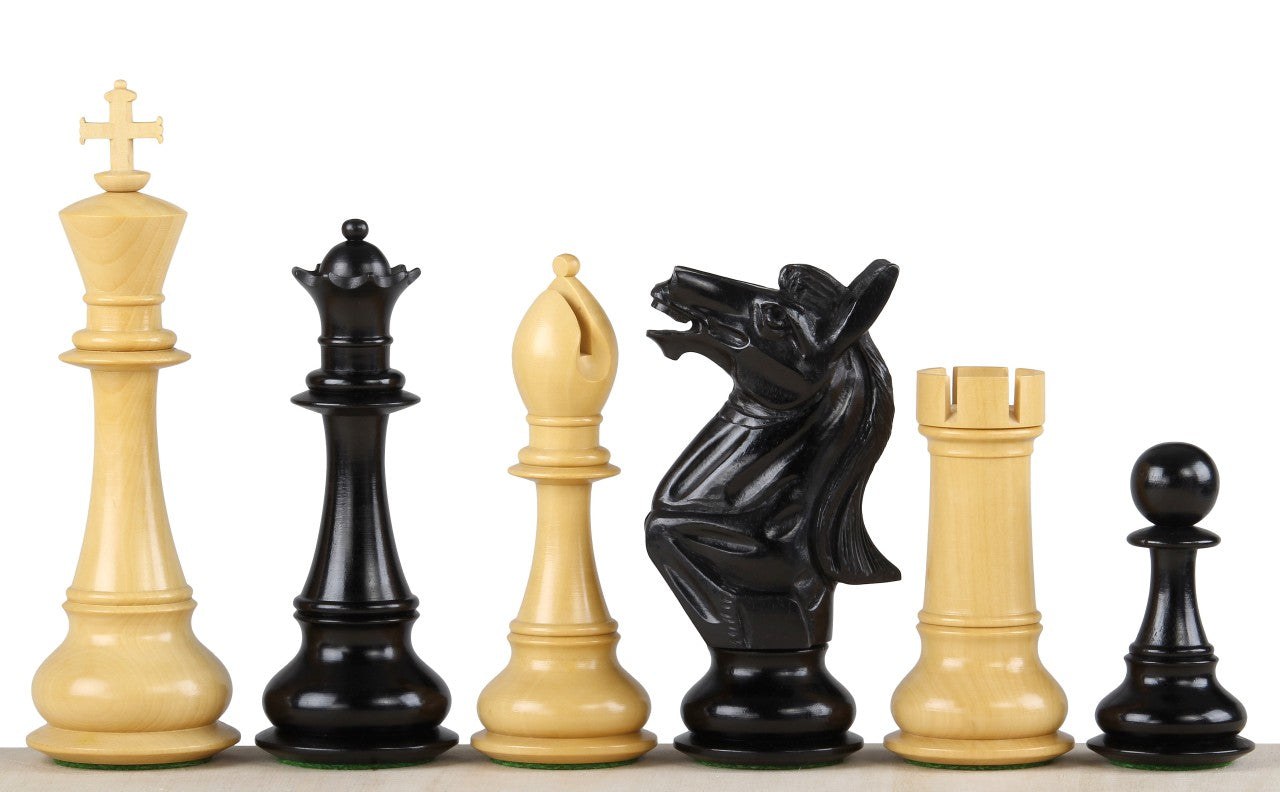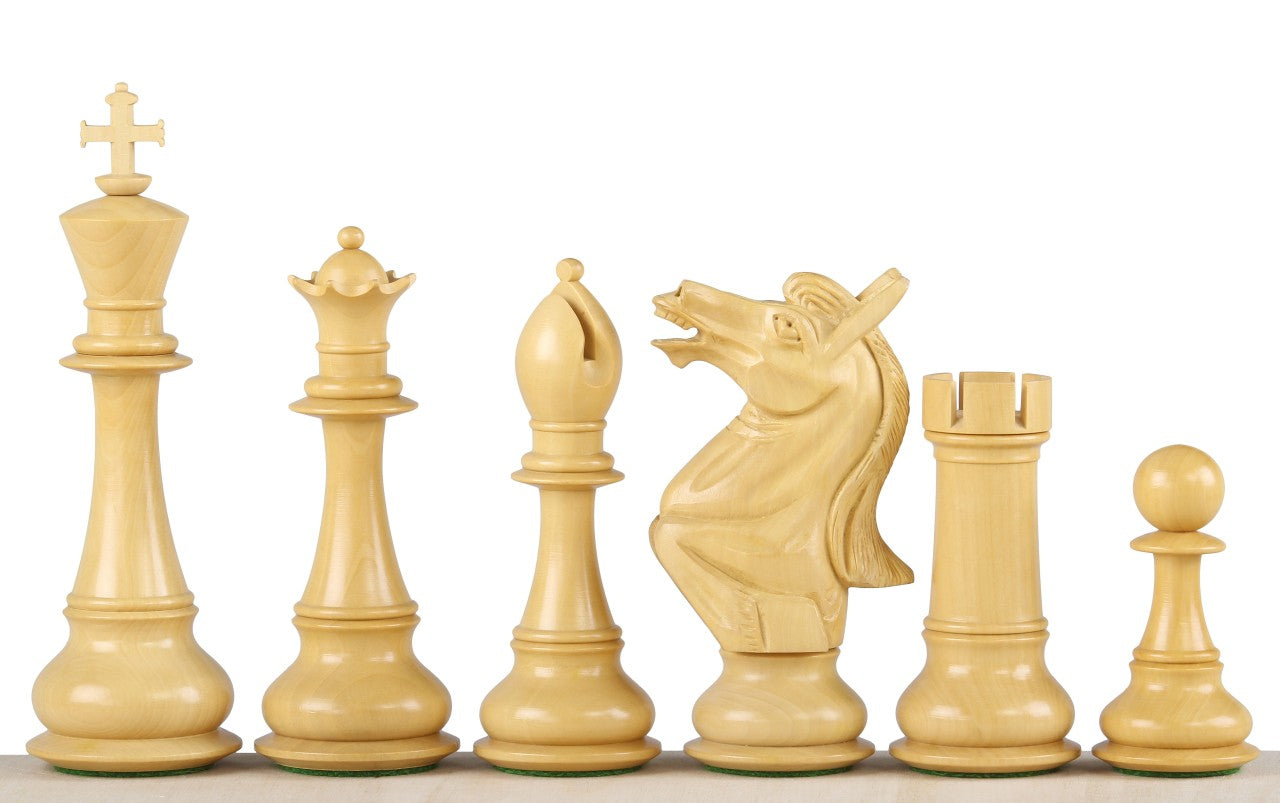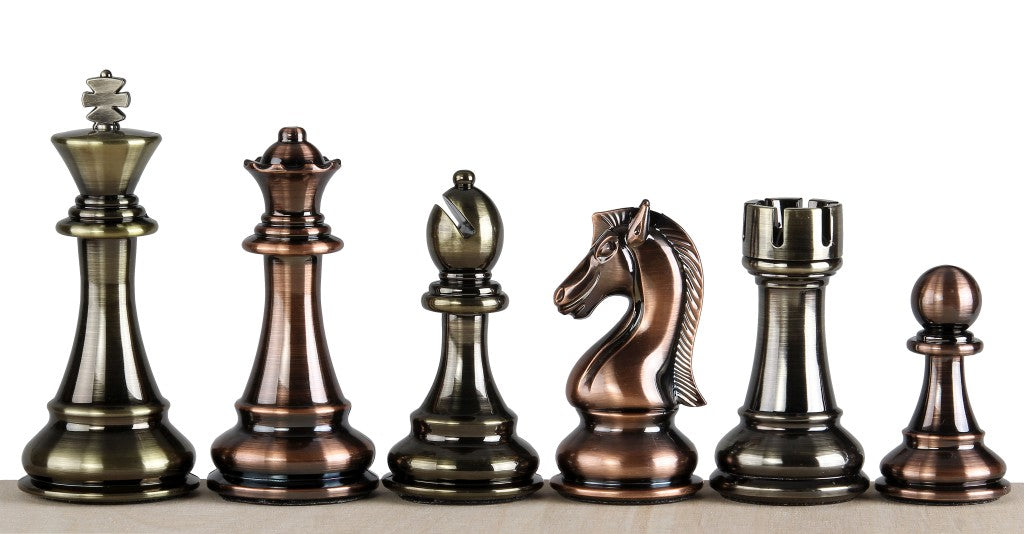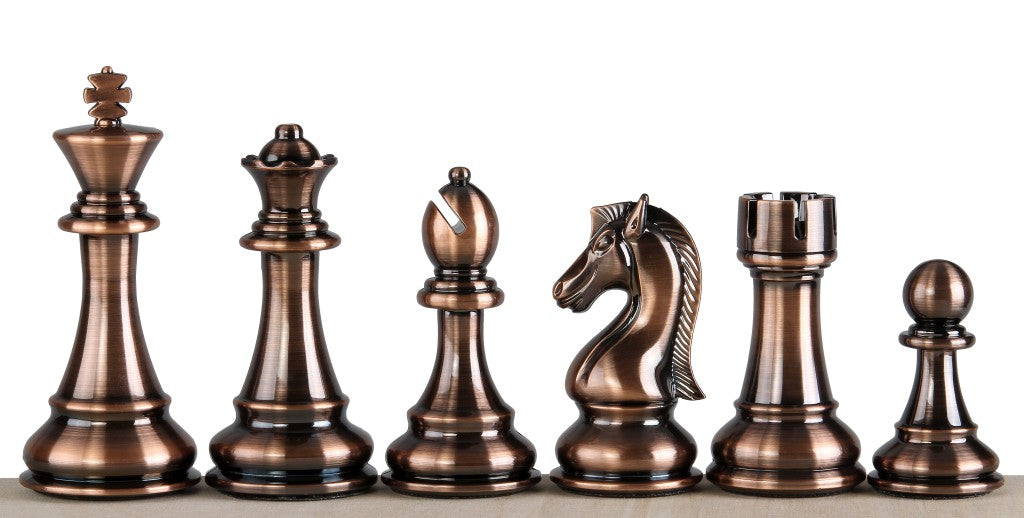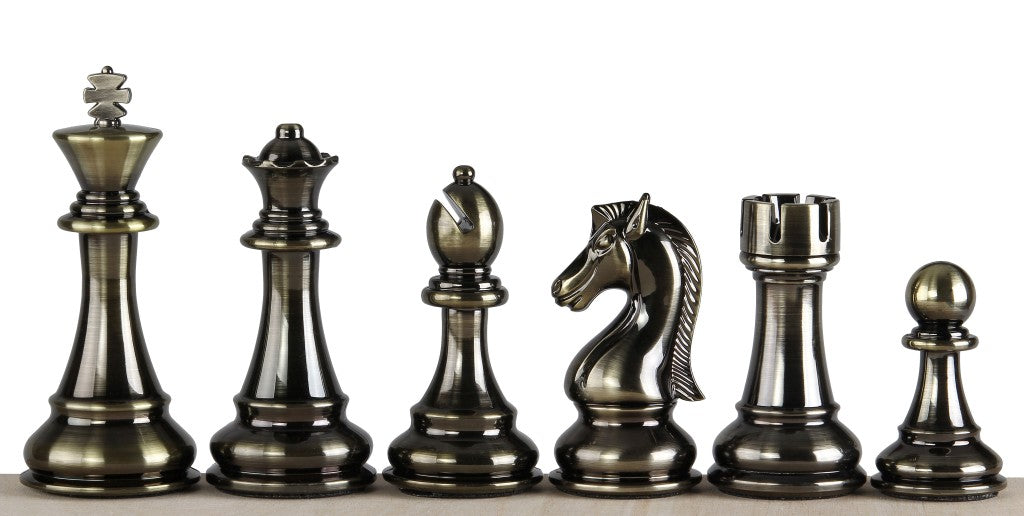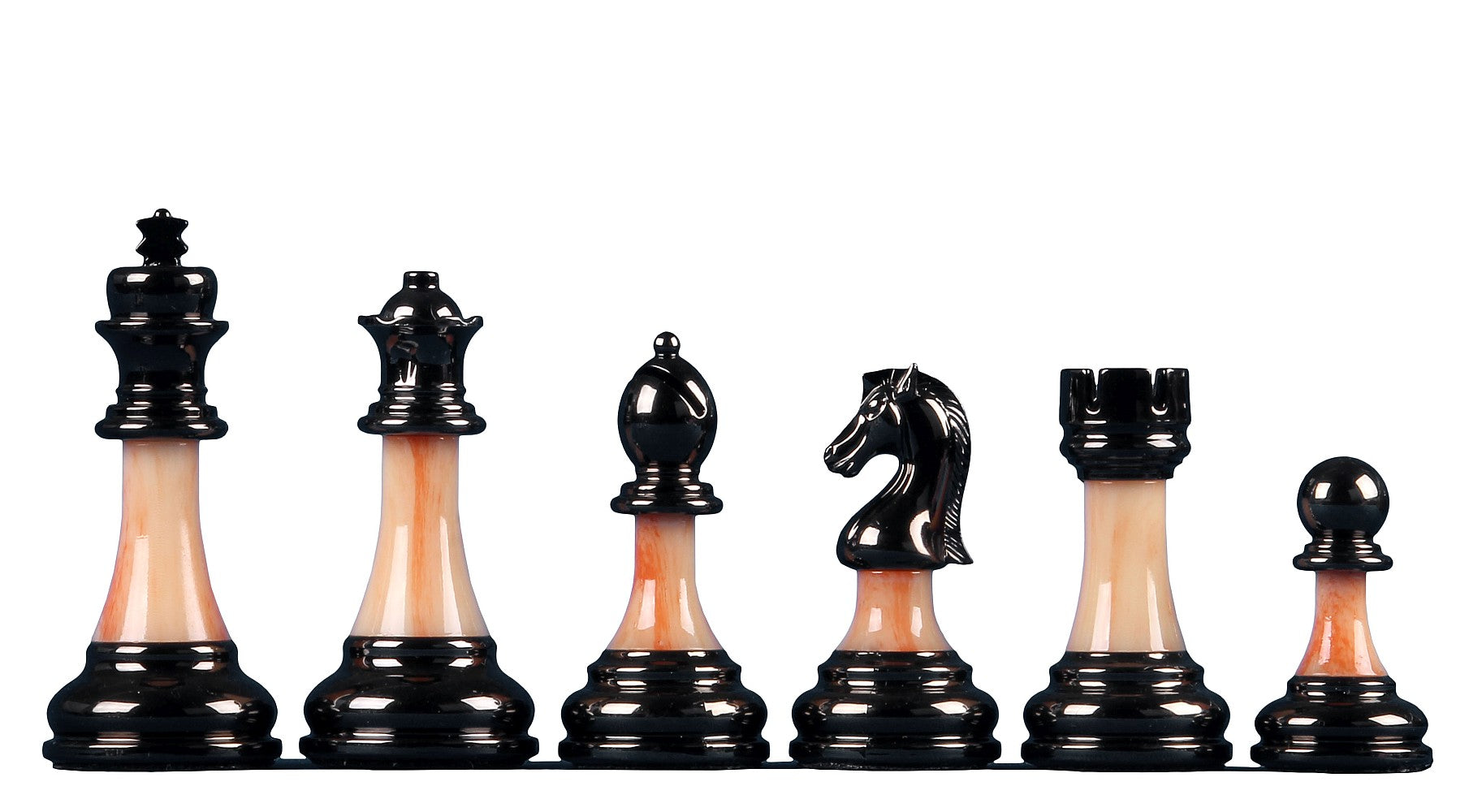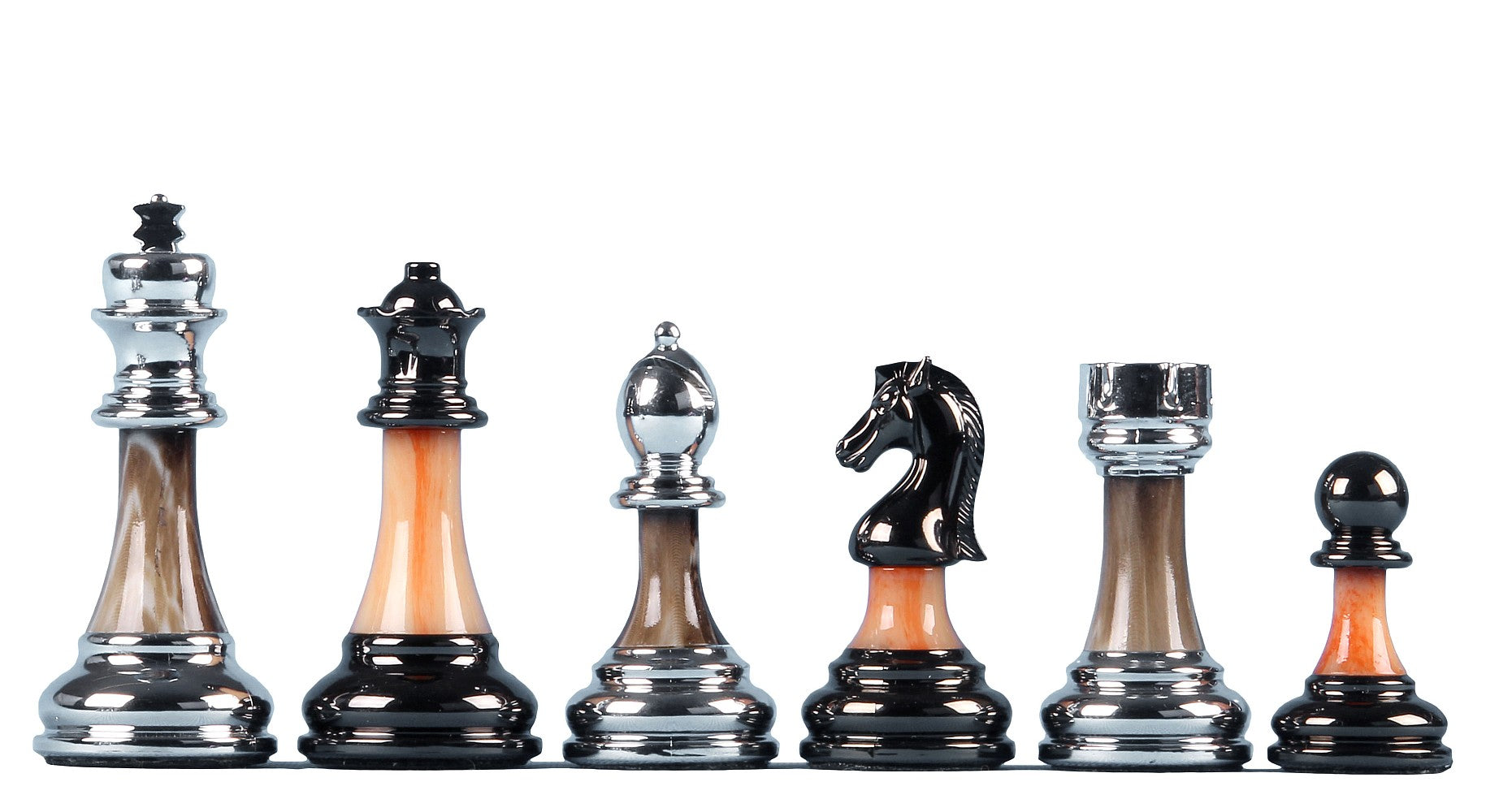Chess Pieces
-
Staunton De Lux No. 5 Chess Pieces with Wooden Box -
Dubrovnik Acacia Chess Pieces – 3.75 Inch Bobby Fischer Style -
Classic Chess Pieces – 3.5" King, Acacia & Boxwood -
Sunrise 4.25" Exclusive Chess Pieces – Redwood -
Sunrise 4.25" Exclusive Chess Pieces – Ebony Finish -
Redwood Sunrise Chess Pieces 4 inch King -
Sunrise 3.75" Ebony Chess Pieces -
Staunton No. 7 Chess Pieces – Hornbeam Wood (3.94″ King) -
Staunton No. 6 Chess Pieces – Transparent Amber and Clear -
Sheikh Ebony Chess Pieces (3.75") -
Sheikh 3.75″ Acacia & Boxwood Chess Pieces -
Sheikh 4 Inch Chess Pieces – Acacia and Boxwood -
Reykjavik 3.75 Inch Chess Pieces – Ebonised Boxwood -
Reykjavik 3.5 Inch Chess Pieces – Ebonised Boxwood -
Reykjavik 3.5 Inch Chess Pieces – Acacia & Boxwood -
Pershing 4.25 Inch Chess Pieces – Ebony & Boxwood -
Oxford 3.75 Inch Chess Pieces – Ebonised Boxwood -
Oxford 3.5 Inch Chess Pieces – Ebonised Boxwood -
Oxford 3.75 Inch Chess Pieces – Acacia & Boxwood -
Oxford 3.5 Inch Chess Pieces – Acacia & Boxwood -
Napoleon 6 Inch Chess Pieces – Red Padauk & Boxwood -
Napoleon Ebony Chess Pieces – 6″ (152 mm) -
Metallic Chess Pieces – 4.5″ Bronze & Silver Finish -
Metallised Chess Pieces – 3.5″ Heavyweight
What Are Chess Pieces?

Chess pieces refers to the 32 playing men in a standard chess set (16 per side). The game’s history dates back over a millennium: chess evolved from the ancient Indian game chaturanga (around the 6th century AD), and over centuries the rules and piece designs spread through Persia and Europe. A key milestone was the 1849 Staunton pattern: Jaques of London introduced a standardized set of pieces (designed by Nathaniel Cooke and endorsed by Howard Staunton). Those classic Staunton pieces, still used in all tournaments today, defined the look of the modern game. Each full set now contains 32 pieces: one king, one queen, two rooks, two bishops, two knights and eight pawns per side.
Name of Chess Pieces
• Pawn : moves straight forward one square, or two squares from its starting rank, captures one square diagonally forward, can perform en passant on an adjacent pawn that has just advanced two squares, and promotes to any higher piece upon reaching the far rank.
• Knight : jumps in an L-shape—two squares in one orthogonal direction then one square perpendicular—ignores any intervening pieces, is the only piece that can leap over others, and always lands on a square of opposite colour.
• Bishop : glides any number of squares diagonally until blocked by a piece or board edge, controls long diagonal lanes, and always remains on its starting colour.
• Rook : moves any number of squares horizontally or vertically, serves as a long-range heavy piece, and partners with the king in the special castling move.
• Queen : combines rook and bishop powers, travelling any distance in a straight line along rank, file, or diagonal, making it the most powerful and mobile piece on the board.
• King : advances one square in any direction, may castle once with an unmoved rook, must never move into check, and is the piece whose safety determines victory or defeat.
Materials & Craftsmanship
Chess pieces are crafted from a variety of materials, each affecting durability and appearance.
Woods & Finishes
High-quality chessmen are often made of hardwood. Common woods include boxwood (a fine-grained pale wood used for lighter-colored pieces)and ebonised boxwood (boxwood stained black to simulate ebony). Rich reddish-brown rosewoods (sheesham or bud rosewood) are prized for their color and grain, while true ebony (jet-black, extremely dense) is used only on luxury sets due to its rarity and cost. Walnut is another popular wood (often paired with maple boards) for warm brown pieces. Many wooden sets are hand-turned on a lathe and finished by hand. A classic finish is a glossy French polish (shellac) that gives a smooth, lustrous surface. In luxury sets, each piece may also be meticulously carved and buffed to highlight the wood’s grain and curves.
Alternative Materials
Beyond wood, many chess pieces use synthetic or decorative materials. ABS plastic is very common for club and tournament sets; plastic pieces are lightweight, affordable, and durable (especially ABS or polycarbonate), though less traditional in feel. Metal pieces (brass, bronze or aluminum) offer substantial heft and can be highly ornate. Metal sets are extremely sturdy and often intricately engraved, but they are heavier, more expensive, and can tarnish over time. Stone or marble sets (for example alabaster or onyx) look luxurious and are very heavy and stable, but they are brittle and must be handled carefully. Glass chessmen (clear, frosted or tinted glass) provide a modern, elegant look. Glass pieces have a satisfying weight and shine, but are fragile and easily chipped, and fingerprints can show on smooth surfaces. Each material has its trade-offs: plastic for practicality, metal or stone for luxury/display, and wood for a balance of tradition and quality.
Weighting & Felt
Many quality chess pieces are weighted to improve balance. Manufacturers add metal inserts (lead or steel) in the base of each piece to give it heft and stability during play. Weighted pieces feel solid and crisp to handle, and are less likely to tip over on a sudden move. In addition, almost all high-end pieces have a felted bottom (often green billiard-cloth). This felt pad protects the board’s finish and allows pieces to glide smoothly. Proper weighting combined with a felt base makes pieces “melt” onto a standard board (55–60mm squares) and keeps them centered. This is particularly noticeable on tournament 2.25″ (57mm) boards, where weighted, felt-bottom pieces feel snug and professional.
Types of Chess Piece Sets & Use-Cases
Staunton Tournament Pieces

The Staunton pattern is the world standard for tournament play. These pieces have traditional Staunton styling and proportions. A common tournament set uses a 3.75″ (95mm) tall king with a base diameter about 75–80% of the square size. For example, a 3.75″ king on a 2.25″ square yields an ideal 77% base-to-square ratio. FIDE regulations even specify a king height of 9.5cm (3.75″) with the king’s base about 40–50% of that height. Tournament Staunton sets also include extra queens (typically 2 additional queens) to allow for pawn promotion. Most are triple-weighted with felt pads on the bottom. The overall look is elegant and unornamented: easy-to-recognize silhouettes in black and natural wood, designed for clarity in serious competition.
Luxury & Collector Pieces
At the luxury end are collector’s sets and limited editions. These often use exotic woods (such as sandalwood, padauk, boxwood/ebony combos) and feature exquisite detail — for example hand-carved knights with intricate manes or themed ornamentation on rooks and pawns. Many are numbered or signed by the artisan, and they usually include a certificate of authenticity. Weighting and high-end finishes are standard; you might see pieces triple-weighted and finished with extra-smooth French polishing for a glassy sheen. Because of the craftsmanship and materials, luxury sets command much higher prices. (For instance, museum-quality ivory or mammoth-tusk sets can cost thousands and come with provenance certificates.) These sets are prized by collectors and often come in elegant display cases or wooden caskets.

Themed & Decorative Pieces

Themed and decorative chess sets put style first. These can depict historical, fantasy or pop-culture themes: for example, medieval armies, Star Wars characters, or whimsical art motifs. Such sets still follow a basic hierarchy (king, queen, etc.) so play is possible, but the figures are often sculptural. Themed sets usually retain Staunton-like bases on the pieces for stability, but with fanciful tops. They are typically heavier on ornamentation than on gameplay practicality. Many collectors buy themed sets purely for display or gift-giving, though they can be used for casual play.
Giant & Garden Pieces

For outdoor or large-format play, giant chess sets are available. These use very large pieces (8″ to 25″ tall) made of weatherproof materials like UV-stable polyethylene or resin. For example, a 25″ giant set has molded plastic pieces – sturdy and waterproof – designed for year-round garden use. The bases of giant pieces are often hollow with threaded screw-in extensions, so you can add weight (sand or water) for extra stability in wind. Boards for these sets have huge squares (often 12–24″ wide) to match the scale; a typical permanent outdoor board might use 14″–20″ squares. Giant sets are popular for parks, resorts or large event spaces, turning a lawn or plaza into a life-size chessboard.
Sizing Guide
Choosing the right set means matching piece and board sizes. A useful rule of thumb is the 75–80% rule: the king’s base diameter should be about 75–80% of the square edge. This ensures pieces fit comfortably without crowding. For example:
-
King ~3.0″ tall ⇒ board squares ~1.75″ (45mm) wide.
-
King 3.75″ tall ⇒ squares ~2.25″ (57mm) wide.
-
King 4.0″ tall ⇒ squares ~2.5″ (64mm) wide.
In practice, official USCF/FIDE sets have 3.75″ kings on 2.25″ squares (giving about a 77% base-to-square ratio). Larger kings (4″–5″) need ~2.5″–3″ squares. Always check the king height against the square size: a too-small square makes pieces wobble; too-big and the board looks empty.
Buying Guide & Pricing Tiers
Chess piece sets come in all budgets:
-
Budget plastic sets (£15–£40): These are mass-produced ABS plastic or injection-molded sets. They’re lightweight, unweighted, and durable – ideal for schools, travel or beginners. The finish is plain, but prices are low.
-
Club/wooden sets (£45–£120): These Staunton sets (often boxwood and sheesham or rosewood) use solid wood and usually have interior weights and felt bottoms. They strike a balance of quality and value. Many club sets have double- or triple-weighting and a nice wax or lacquer finish, making them a popular tournament choice.
-
Luxury/collector sets (£150+): In this tier, exotic materials and craftsmanship drive prices up. Expect expensive woods (ebony, rosewood, padauk), hand-carved details, museum-quality knights, and heavy weights. Limited editions or vintage reproductions can cost hundreds or thousands, especially if they come with presentation cases and certificates of authenticity. In short, the more handwork, rarity of wood, and personalization (carving, engraving, certificates) a set has, the higher the price.
Care & Maintenance
To keep your chess pieces looking their best: dust wooden pieces regularly with a soft cloth or brush. If they get dirty, wipe wood gently with a slightly damp cloth, then dry immediately. Never soak wooden pieces or use harsh chemicals – a mild wood polish or wax can restore shine if needed. For plastic or metal pieces, mild soap and water will do, but dry them thoroughly to avoid corrosion. Inspect felt bottoms and replace any that come loose or worn. Store pieces in a lined wooden box or padded bag when not in use to prevent scratches and handle moisture. Avoid exposing wooden sets to extreme humidity or direct sunlight, which can warp or fade the wood over time.
Accessories & Add-Ons
Boards
Choose a chessboard that matches your pieces in size and style. The board’s square size should accommodate your king (see Sizing Guide above). Wooden boards often come in matching materials – for example, a maple & walnut board looks natural with boxwood/sheesham pieces. Some boards have inlaid wood veneers (maple/rosewood) for a classic look. Match tone and finish too: a satin-finish board complements matte Staunton pieces, while a glossy board goes with polished pieces. Vinyl or roll-up vinyl boards can also work for plastic club sets. Ultimately, pick a board whose aesthetics and square size complement your pieces.

Boxes & Caskets
Quality chess boxes protect and present your pieces. A good box has separate trays (often one per color) lined in soft felt or velvet, sized for the king height and extra queens. Lockable wooden caskets or leatherette cases keep dust out and humidity low. Many boards have matching storage: for example, handcrafted boxes in a walnut finish to match a wooden set. Pictured below is an example dual-tray box designed for up to a 4″ king. Look for sturdy construction and interior straps or dividers to keep each piece snug.
Clocks
A chess clock is essential for serious play. Clocks come in digital or analog (mechanical) versions. Digital clocks (often battery-powered) are standard in tournaments: they allow precise time controls (increment/delay) and have clear LED displays. Mechanical clocks have a classic appeal and often match wooden sets (e.g. a rosewood clock with a rosewood board). Choose a clock with a reset flag or easy-to-read buttons. The design should complement your set: sleek plastics suit modern sets, while carved wooden clocks suit traditional sets. Remember, any chess clock will let you time games properly, so match function with style preference.

Shipping, Returns & Customer Service
We pride ourselves on fast, reliable service. Orders are processed within 24 hours of purchase. We offer free UK shipping on orders over £150 and tracked international shipping for overseas customers. Every order is securely packaged (often in plain gift packaging at your request), and we include care instructions. We also stand behind our chess products: we have a 30-day returns policy and a money-back satisfaction guarantee. In fact, our terms echo industry standards – as noted on our UK site, we provide “30 DAY RETURNS” for a full refund. Similarly, we extend a full satisfaction guarantee on our products. If you have any issues, our customer service team is ready to assist with exchanges, replacements or expert advice.
FAQ
What are the 16 chess pieces called?
Each player commands 16 chess pieces: 1 King, 1 Queen, 2 Rooks, 2 Bishops, 2 Knights and 8 Pawns. Together they total 32 pieces on the board at game start.
Which chess piece is the most powerful?
The Queen is the most powerful piece. She combines the long-range movement of both rook and bishop, able to travel any number of squares along rank, file or diagonal.
What is the weakest chess piece?
The Pawn is the least valuable in raw power, advancing only one square at a time and capturing diagonally. Its strength, however, grows as it nears promotion on the final rank.
Why is the knight sometimes called a horse?
Informally the knight is nicknamed “horse” because its Staunton design depicts a horse’s head. The official term is Knight, reflecting its original Persian name asp (horse) and medieval role as mounted cavalry.
How does each chess piece move?
Pawns move forward one square (two on their first move) and capture diagonally. Knights jump in an L-shape, two squares in one direction and one perpendicular. Bishops glide diagonally any distance. Rooks travel horizontally or vertically any number of squares. The Queen combines rook and bishop moves, while the King moves one square in any direction and can castle once per game.
Which chess pieces can move backward?
Knights, Bishops, Rooks, Queens and Kings all move backward within their normal patterns. Pawns are the only pieces that cannot move backward.
Why is the rook sometimes called a castle?
The rook’s silhouette resembles a fortified tower, leading to the colloquial name “castle.” In early Persian chess the piece was called rukh (chariot). Modern rules still use the term rook, though “castling” describes the special king-rook move.
Is the bishop or rook more valuable?
Traditionally a rook is rated at 5 points while a bishop is valued at 3. Though bishops control long diagonals, rooks dominate open files and are stronger in endgames, making them materially superior.
What are the original names of chess pieces?
In ancient Indian chaturanga: King (Raja), Queen (Mantri), Bishop (Gajah – elephant), Knight (Ashva – horse), Rook (Ratha – chariot) and Pawn (Padati – foot-soldier). These evolved into the modern English names through Persian and European translations.
What are the most important squares in chess?
The four central squares—e4, d4, e5 and d5—are critical because control of the centre allows your pieces greater mobility and influence across the board. Strong central occupation often leads to better piece activity and strategic advantage.
How are chess pieces arranged at the start of a game?
Pawns fill the second rank for White and the seventh rank for Black. Rooks occupy the corners, Knights next to them, then Bishops. The Queen starts on her own colour (white queen on d1, black queen on d8) and the King takes the remaining central square (e1 for White, e8 for Black).
What is en passant in chess?
En passant is a special pawn capture. When an opposing pawn advances two squares from its starting rank and lands beside your pawn, your pawn may capture it “in passing” as if it had moved only one square. This option must be taken immediately or it is lost.
Can pawns move backward?
No. Pawns only move forward: one square straight ahead (two on their first move). They capture diagonally forward and never retreat.
Why do bishops stay on the same colour?
A bishop moves exclusively along diagonals. Because a diagonal never changes square colour, each bishop always remains on the colour of its starting square, giving one light-square and one dark-square bishop per side.
How many queens can a player have?
Through pawn promotion a player can have multiple queens on the board at once. The theoretical maximum is nine—one original queen plus eight promoted pawns.

